Road bike groupsets: Shimano, SRAM and Campagnolo hierarchies explained
What exactly is a road bike groupset? Should you pick Shimano, SRAM, Campagnolo or other? Here's your complete guide to this essential piece of kit for your bike
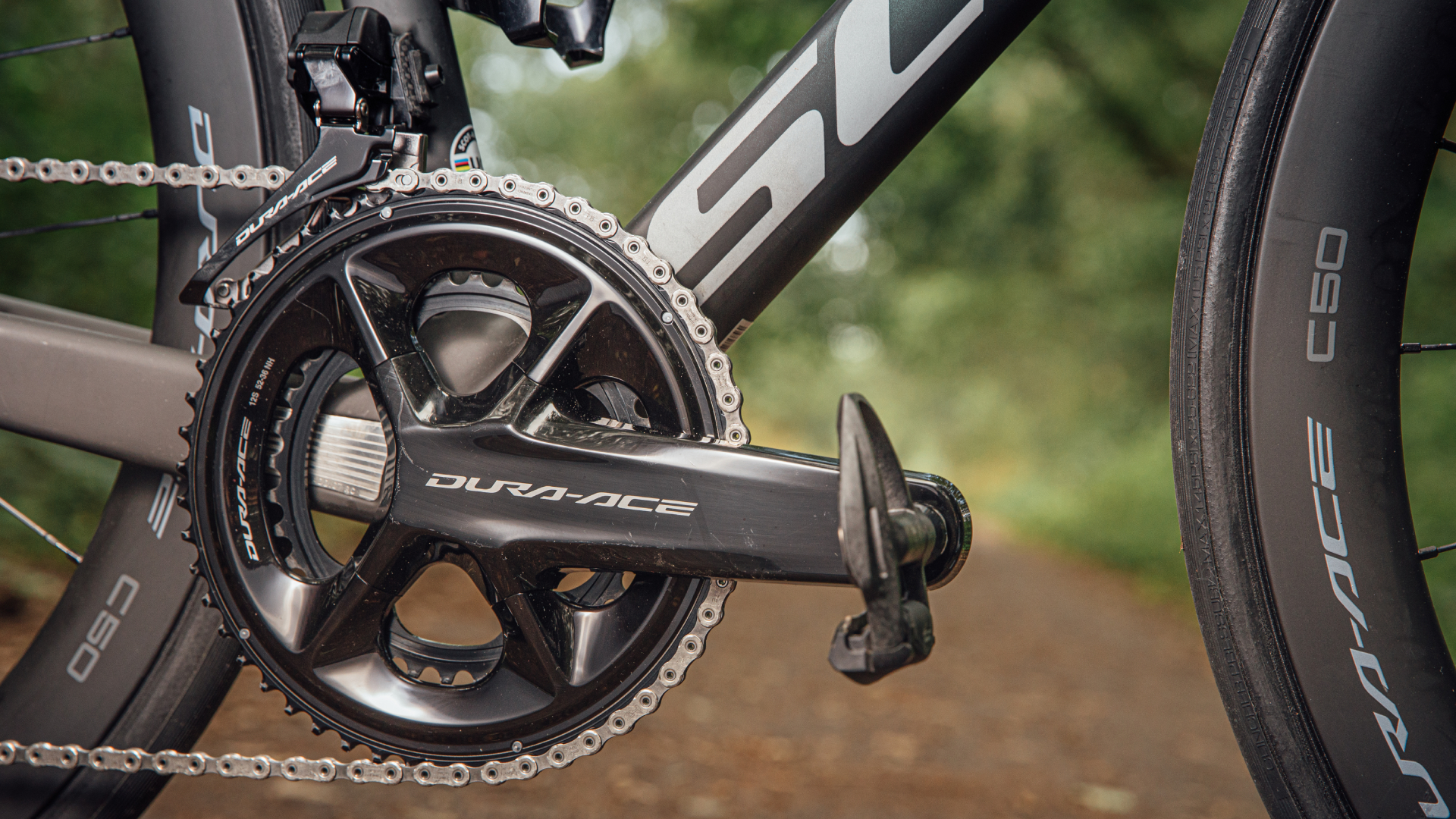

Sonny Evans
A road bike groupset includes any parts involved in braking, changing gear or running the drivetrain. This includes the shifters, brake levers, front and rear brake calipers, front and rear derailleurs (sometimes called mechs), crankset, bottom bracket, chain and cassette.
Other components like pedals may also share the groupset's name but they're not considered part of the 'core' groupset.
When you're buying a new bike, after the frame, the groupset is the second determining factor in value for money. Groupsets higher up the hierarchy will be lighter, may last longer, and in some cases may have improved functionality such as more immediate responses to shifting and braking.
Increasingly, the highest spec groupsets are electronic, where a battery and motors shift gears for you in response to electronic commands sent either via wires or wirelessly to the derailleurs.
There are three main manufacturers of groupsets and bike components. Shimano is the largest and best known, while the other two of the 'big three' are Campagnolo and SRAM. All three manufacturers offer a range of groupsets at competing price points.
Read further down the page for information on individual components - whilst you'll find information about the 'big three' providers below...
Shimano groupset hierarchy
The large majority of built road bikes come with a primarily Shimano groupset, though you'll sometimes find they include some components from other brands to keep costs down - such as TRP brakes or FSA chainsets.
The Japanese brand offers a wide range of groupsets - starting with Claris and Sora, which you'll find on entry level road bikes. Tiagra is the next step up, followed by Shimano 105 which is typically specced on bikes costing upwards of $2,000 / £1,500.
Shimano 105 is considered Shimano's first performance groupset, and for many people it is the best option in combining performance, value and longevity. Shimano offers 105 with mechanical (cable operated) shifting, but also with 12-speed electronic shifting, called Shimano 105 Di2.
Ultegra is next and is very similar to Dura-Ace in terms of performance, though Dura-Ace is lighter. You'll find Ultegra on bikes from around $5,000 / £4,000 and Dura-Ace on the most expensive bikes, typically retailing for $8,000 / £7,000 and upwards.
The latest versions of Ultegra and Dura-Ace are 12-speed, with Shimano's Di2 electronic shifting system.
Dura-Ace, Ultegra, 105 (but not 105 Di2) and Tiagra models offer the option of hydraulic disc brakes as well as rim brakes. Lower down the pecking order, you'll either get mechanical disc brakes or rim brakes, often from a brand other than Shimano.
Shimano also produces GRX, its first dedicated gravel bike groupset, offering it in both mechanical and electronic 11 speed, as well as mechanical 10 speed, and all with hydraulic disc brakes.
Within each groupset there's a series number, so the latest Shimano Dura-Ace R9200 supersedes the older Dura-Ace R9100, which itself was a successor to Dura-Ace R9000, etc. If you're looking to replace parts of a groupset make sure that you've got the right series number; many parts are cross-compatible between series but some aren't.
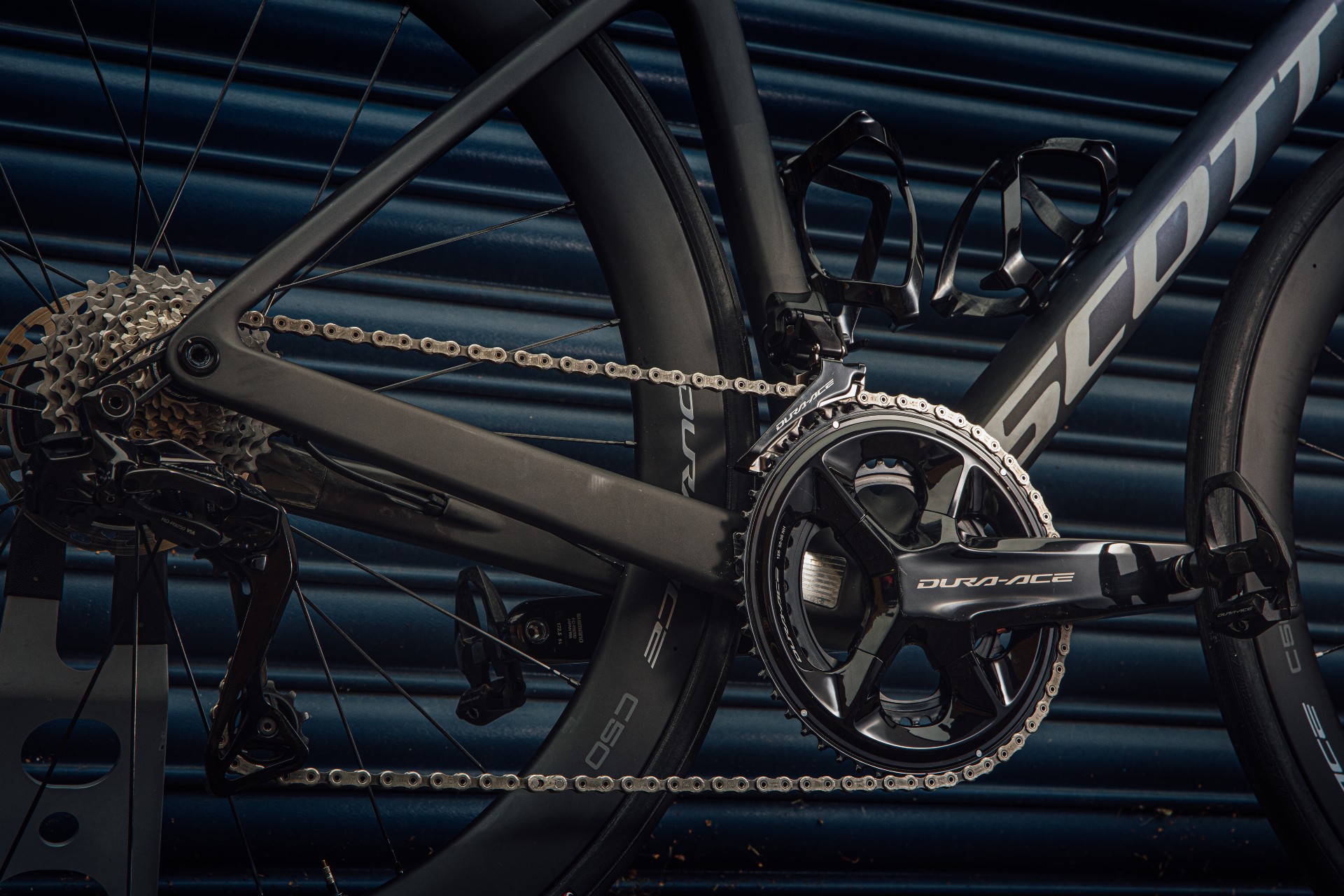
Specifications
Reasons to buy
Reasons to avoid
Shimano Dura-Ace R9100 was superseded by Shimano Dura-Ace R9200 in 2021. This new 12-speed groupset is semi-wireless with the option of wireless communication from the levers to the derailleurs, which are powered via wires to a central battery mounted within the bike's frame. It also features improved disc braking technology.
Whilst Shimano will continue to manufacture parts to serve existing set-ups, new Dura-Ace is now Di2 only. There is still a rim brake option if you prefer rim brakes.
According to Shimano, Dura-Ace 9200 offers an increase in shifting speed, with a claimed 58 percent decrease in rear derailleur operating time and a 45 percent decrease in front derailleur operating time.
The shifters have grown in size; Shimano said this was because they'd become too small, and pros complained they felt unstable on uneven ground, but the argument could be made that tech changes made a hood size increase necessary. Dura-Ace can be set up with satellite shifter buttons that are wired into the main levers, allowing you to shift from the bar tops or the drops in addition to the main levers.
The groupset uses a Hyperglide+ cassette - similar to the brand's mountain bike options, which is claimed to speed up rear shifts. The cassette still starts with an 11t sprocket, the gaps are just now smaller between the 6th, 7th and 8th sprockets.
Shimano has released a new 54/40 chainset, replacing the 53/39 - the 50/34 and 52/36 still exist. You can buy a dual-sided Dura-Ace power meter as well as a non-power meter chainset.
At the back, the two options are 11-30 and 11-34, there is no longer an 11-25 as Shimano said few riders opted for this narrow range. An 11-28 was promised at launch but is not yet available.
Shimano made changes to the braking tech within this launch. The gap between the pad and rotor was increased, and 'Servo Wave' tech was incorporated - again, this comes from the mountain bike family and is aimed at reducing the free stroke and creating a more immediate connection between the pads and rotors.
- Read our full Shimano Dura-Ace R9200 review
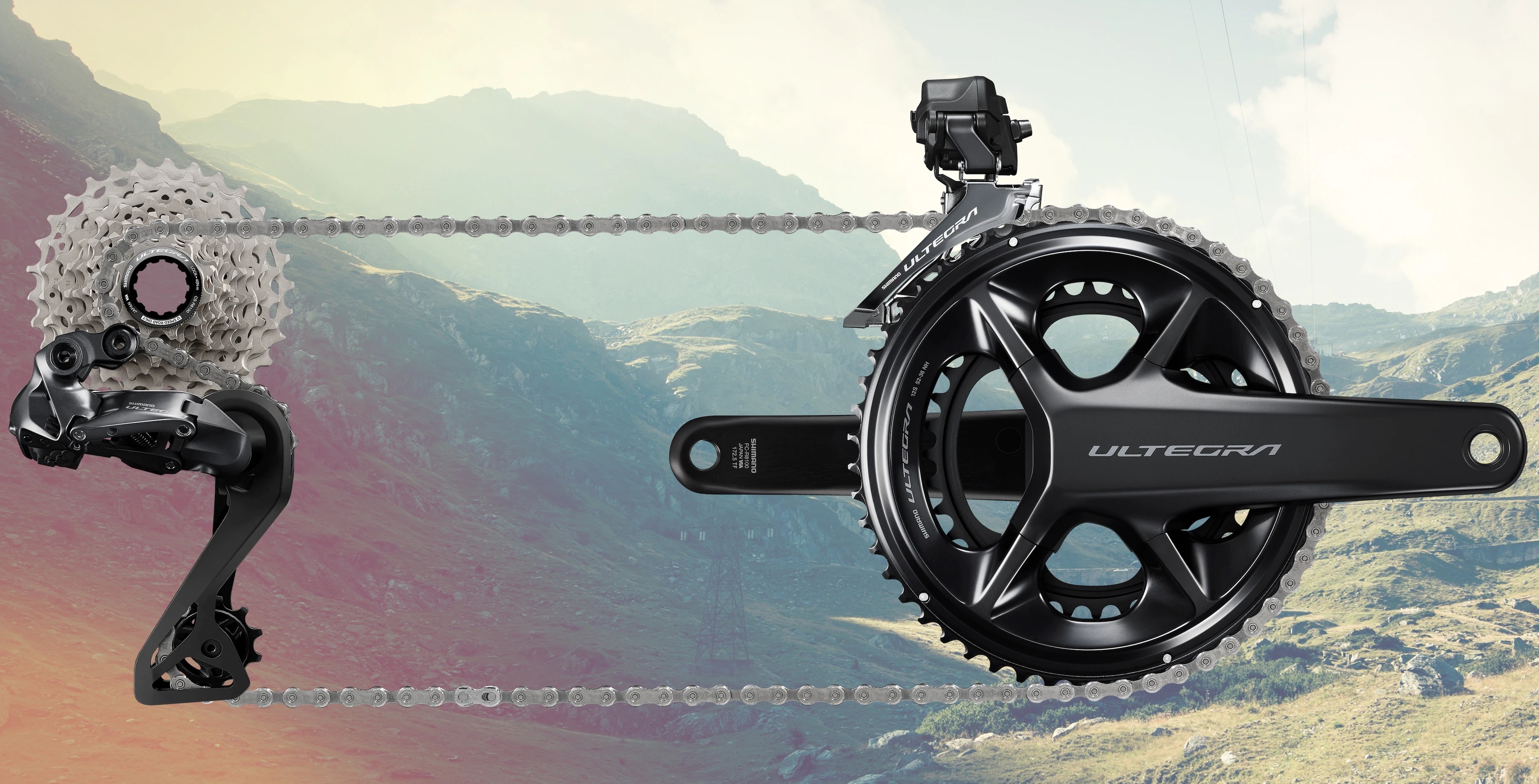
Shimano Ultegra - R8100 series
Specifications
Reasons to buy
Reasons to avoid
Shimano Ultegra is considered to be the thrifty racer's choice, carrying much of the performance of Dura-Ace, with a reduced price tag. This applies even more so with the launch of Shimano Ultegra R8100, which coincided with that of Dura-Ace R9200 - meaning the groupsets share a lot of identical tech.
The newest 12-speed Shimano Ultegra family - R8100 supersedes 11-speed Ultegra R8000 and the two are not compatible.
The new groupset uses the same semi-wired platform as Dura-Ace R9200 and enjoys Servo Wave tech at the brakes whilst also featuring the same increase in the size of shifter hood.
As per Dura-Ace, there is the option to spec the groupset with a power meter as standard.
It's rare for Shimano Dura-Ace and Ultegra to be launched simultaneously, and this pattern allows consumers to enjoy many of the technologies that would usually take a year to trickle down - immediately.
Whilst both rim and disc brakes are supported, new Ultegra is Di2 only; Shimano is aware that there are many users still enjoying existing mechanical Ultegra, and it will continue to make these components available.
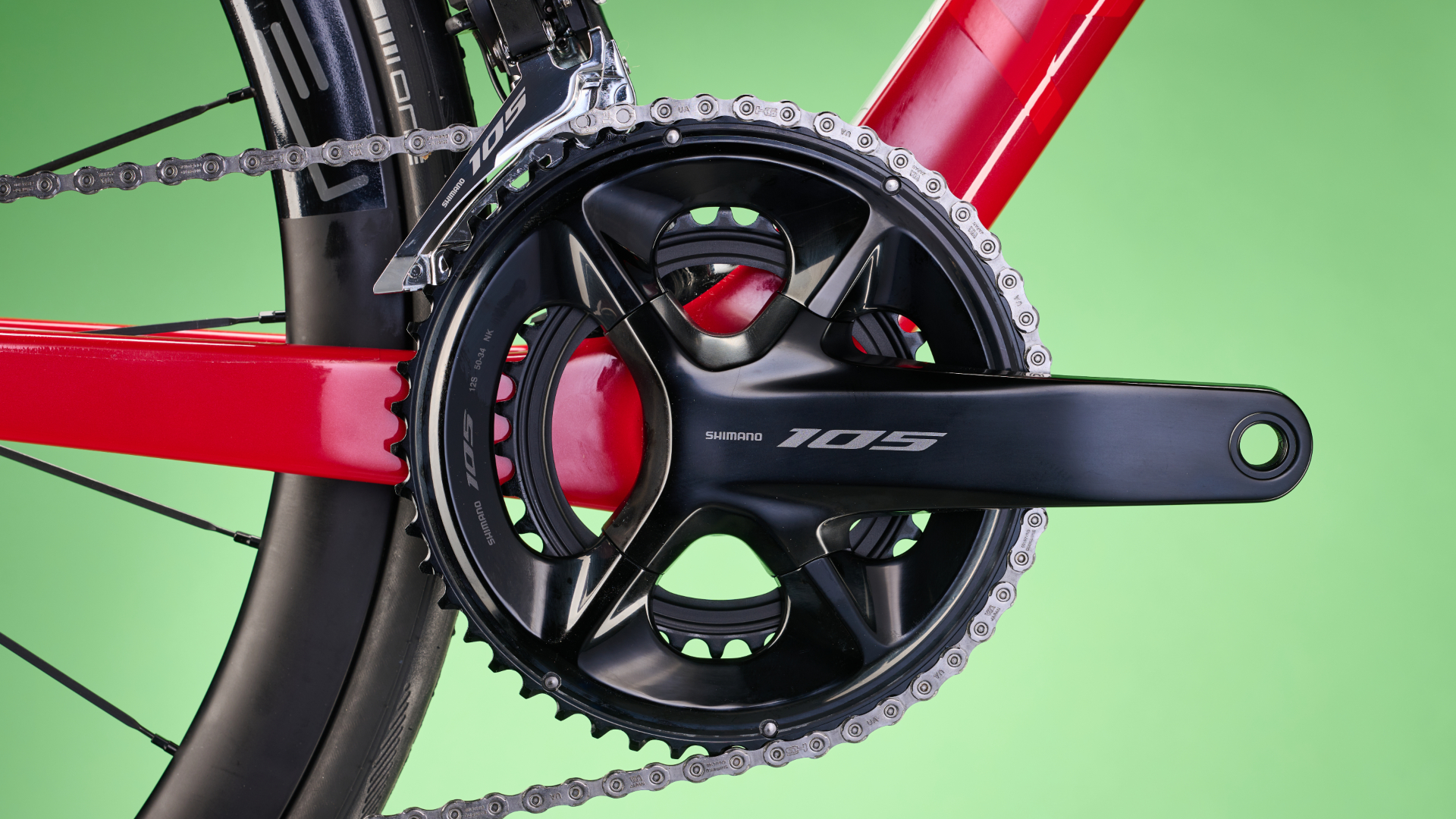
Specifications
Reasons to buy
Reasons to avoid
Shimano 105 is currently split into two strands, the newer 12-speed, electronic R7100 groupset and the older 11-speed, mechanical R7000 groupset.
Touching on the 11-speed and mechanical version first, over the years 105 R7000 has earnt a reputation for being the 'groupset of the people'. The performance in terms of the shifting and the braking was near identical to that of Dura-Ace and Ultegra - Shimano's flagship and second tier groupsets, and yet the retail price of 105 is significantly less than those two product lines.
There is, naturally, a weight penalty between mechanical 105 and its more expensive counterparts. But, on the other hand, 105 is very hard wearing, making it an excellent choice for a more performance oriented winter bike.
Shimano 105 Di2, with its 12-speed cassette and electronic shifting, is similarly a cheaper version of Ultegra and Dura-Ace - and again has only a handful of minor penalties in comparison to those more expensive groupsets. Again, 105 Di2 does weigh more and it doesn't get Shimano's latest and greatest 'servo wave' braking technology, meaning it doesn't ascend to the same heights as the most expensive groupsets.
But, on the other hand, you get those excellent new gear ratios, providing a greater range with smaller jumps between the gears. On the road you'll experience this as being less likely to run out of gears when climbing and having enough at the high end to not spin out on fast descents - as well as being less likely to find yourself stuck between two gears, one too hard and the other too easy.
Then there are the benefits of electronic shifting - crisp shifting every time and never having to rethread a gear cable through your frame as part of your yearly servicing. Plus the brake calipers have been redesigned to make the bleed process easier, as well as ergonomic changes to the shifters making those more comfortable to grip from a greater range of positions.
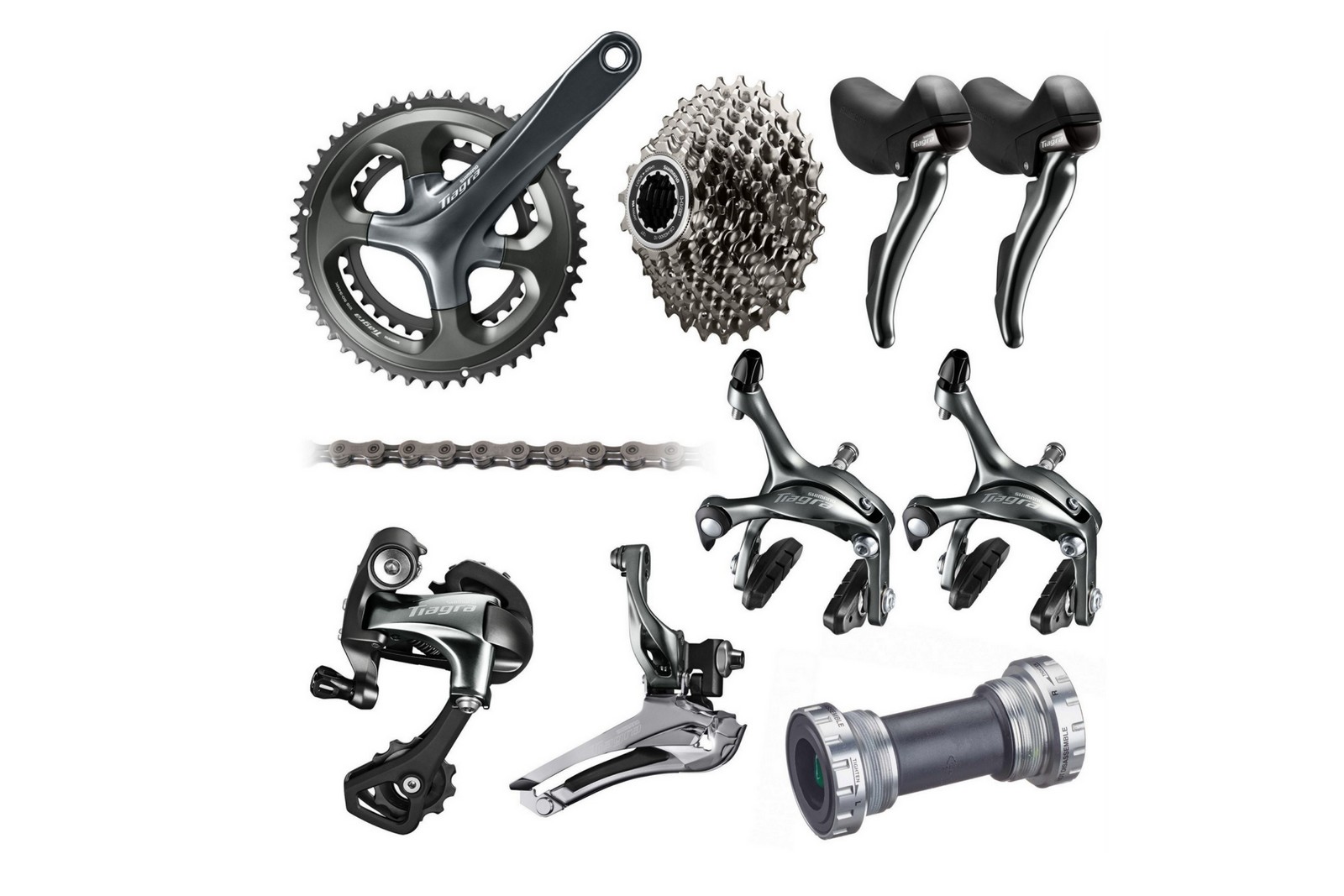
Specifications
Reasons to buy
Reasons to avoid
Shimano Tiagra groupsets and below have yet to receive the more recent updates, retaining the older rear derailleur shape instead of Shimano's more wrap-around Shadow rear mech profile.
The 2016 update - Shimano Tiagra 4700 - however, did incorporate gear and brake cables that could be fed beneath bar tape, reducing the "anti aero loop" on previous editions. It's compatible with flat bar bikes, too.
Tiagra is also still 10-speed, and the chainsets available are 52/36t, 50/34t, 48/34t and 50/39/30t - the larger, more race focused 53/39t option available higher up the foodchain won't be found here. There is the option for hydraulic disc brakes though.

Specifications
Reasons to buy
Reasons to avoid
Shimano showed its Sora groupset (R3000) a bit of love in 2017, with new shifters, brakes and rear derailleurs which carry a more sophisticated aesthetic.
The chainset, like Tiagra, is now four arm which allows it to be lighter - and it comes as a 50-34 compact or 50-39-30 triple and the whole setup can be introduced to flat bar bikes (on a five arm crankset with chainguards). Cassettes can be as large as 11-32, which allows plenty of gear options.
The groupset continues to be 9-speed, but it does have new shifters which allow for neater internal cable routing. The rim brakes are said to be improved with 20 per cent greater stopping performance on the previous version thanks to the addition of dual pivot calipers. There's no in-series disc brake option.
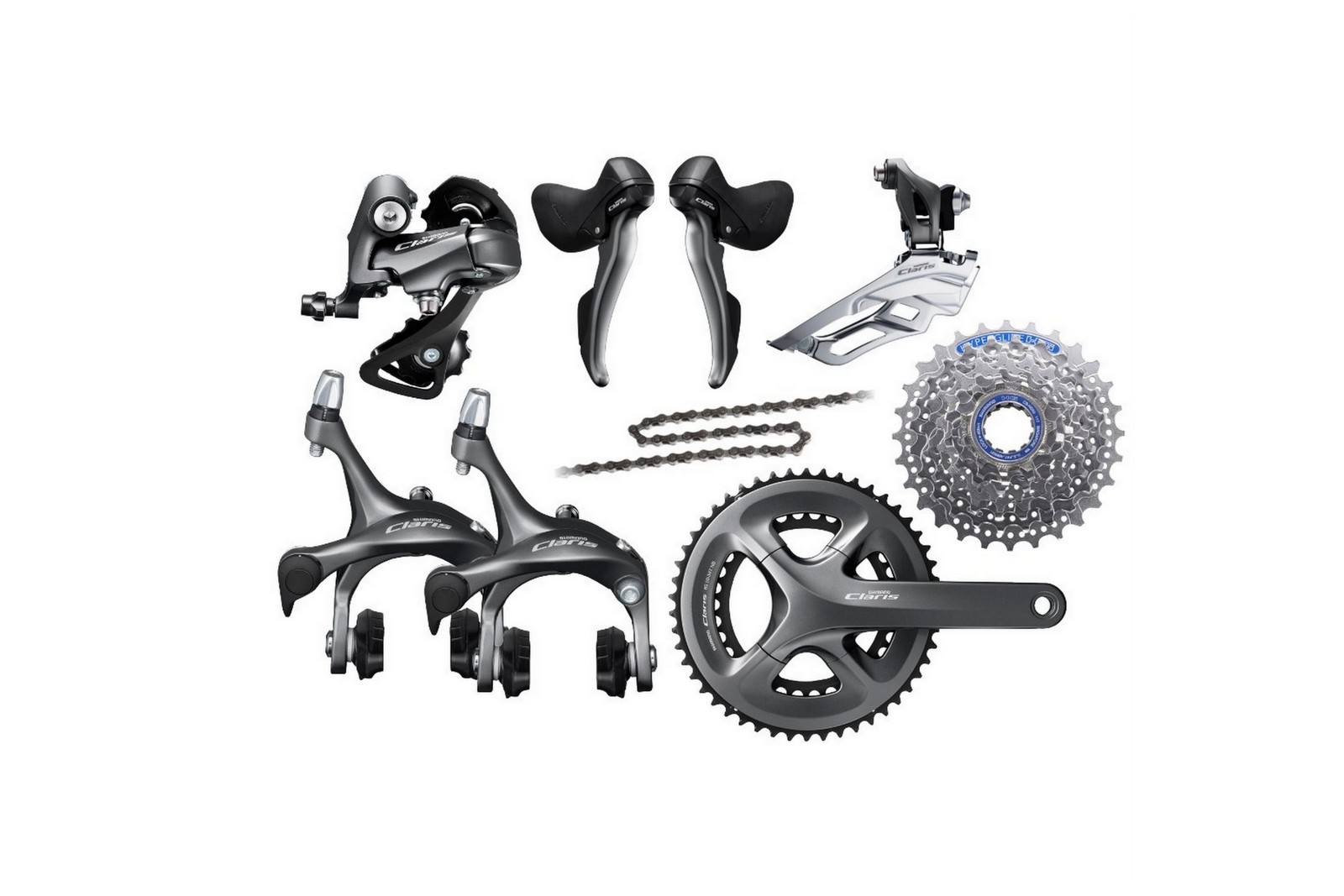
Specifications
Reasons to buy
Reasons to avoid
Shimano's entry level Claris R2000 groupset is 8-speed, provides excellent value and has the clean looks of the brand's higher spec options.
There is a cheaper option - Shimano Tourney - but you won't find it on many built bikes and Claris has one up on it because it uses the same Dual Control shifting action and hidden cabling as the other key groupsets for its drop bar levers. Tourney, on the other hand, still features a thumb lever on the inside of the hood to shift up. Claris also has its own matching brake system and there are flat bar shifters available, as well as double and triple chainsets.
Though Claris is perfectly effective, the letdown is its 8-speed shifting. You can get six different cassettes with ranges from 12-25 up to 11-34, so there are plenty of gearing options. But with only eight gears, the larger range cassettes have large jumps between ratios, which can lead to clunky shifting.
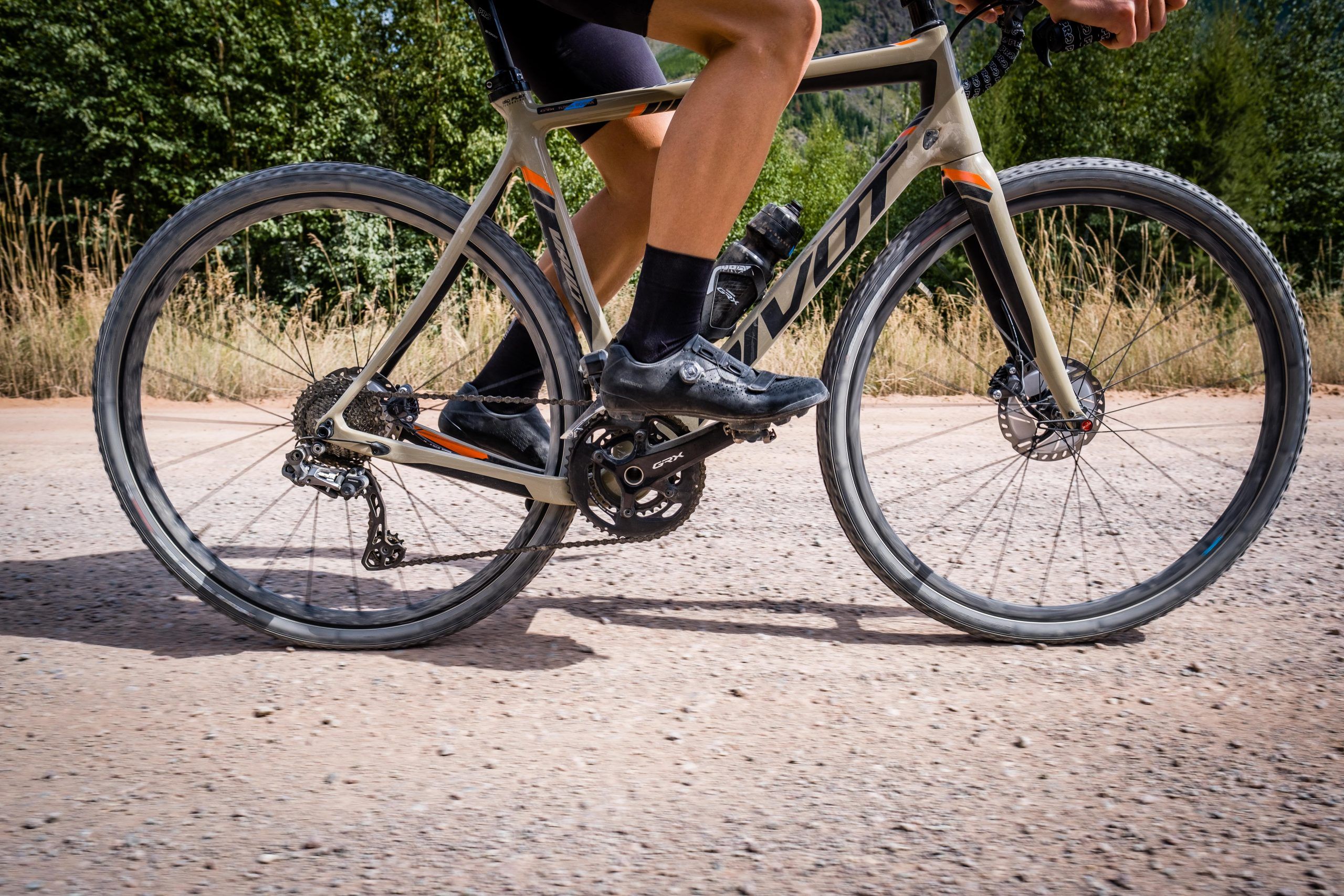
Specifications
Reasons to buy
Reasons to avoid
Shimano GRX was launched in 2019, with the goal of offering a groupset tailored to the growing trend towards bikes designed to traverse mixed terrain.
There are three key levels of spec: 11-speed RX810 and RX600 and 10-speed RX400. To make things even more confusing, RX815 is an electronic Di2 system, whereas RX810 has mechanical shifting. There are single chainring and double chainring versions at RX810 and RX600 spec level too.
Gravel ready features include grippy levers, and front derailleurs which are built with 2.5mm more outbound clearance for wider tires. The rear mech comes with Shimano's chain stabilizing clutch system known as SHADOW RD+ to manage ‘chain chatter', and there's integration for dropper seat posts.
11-speed rear mechs come in two flavours: the short cage version for two chainrings will handle cassettes up to 34 teeth, whereas the long cage version works with a single chainring and cassettes with up to 42 teeth. Chainrings are smaller to give lower ratios than those found on Shimano's road groupsets.
Unlike the rest of the Shimano groupsets, where to ensure smoothest operation it’s best to keep the whole groupset within the same range, GRX is more of a pick and mix system, which enables you to match your shifting to your specific gravel/ adventure needs.
This means that there are countless configurations to choose from, and although we’ve included the most likely options in the table below, we haven’t added in the additional dropper seat post option, with corresponding lever, or the Hydraulic Disc Sub Brake Lever – which can be added to all the options.
Shimano groupset weights and RRPs
| Name | What is it? | Weight* | RRP** |
| Shimano Dura-Ace R9200 | Di2, disc, 12 speed | 2438.5g | £3700.99 |
| Shimano Ultegra R8100 | Di2, disc, 12 speed | 2616.5g | £2399 |
| Shimano 105 Di2 | Di2, disc, 12 speed | 2992g | £1,730 |
| Shimano 105 R7020 | Mechanical, disc, 11 speed | 2,478g | £816.91 |
| Shimano 105 R7000 | Mechanical, rim, 11 speed | 2,467g | £595.99 |
| Shimano Tiagra 4700 | Mechanical, Disc, 10 speed | 2,585g | £749.99 |
| Shimano Sora R3000 | Mechanical, rim, 9 speed | 2,660g | £456.92 |
| Shimano Claris R2000 | Mechanical, rim, 8 speed | Unconfirmed | £396.92 |
| Shimano GRX RX810 – 1 + RX815 (short) | Di2, Disc, 11speed, 1x (40T or 42T ) | 2334g | £1289.92 |
| Shimano GRX RX810 – 1 + RX817 (Long) | Di2, Disc, 11speed, 1x (40T or 42T) | 2464g | £1254.92 |
| Shimano GRXRX810 - 2 + RX815 (short) | Di2, Disc, 11 speed 2x(48-31T) | 2762g | £1529.91 |
| Shimano GRX RX810 - 2 + RX817 (long) | Di2, Disc, 11 speed, 2 x (48-31T) | 2686g | £1494.91 |
| Shimano GRX RX810 – 1 + RX810 (short) | Mechanical, Disc, 11speed, 1x (40T or 42T ) | 2195g | £1099.92 |
| Shimano GRX RX810 – 1 + RX812 (long) | Mechanical, Disc, 11speed, 1x (40T or 42T ) | 2306g | £1084.92 |
| Shimano GRX RX810 – 2 + RX810 (short) | Mechanical, Disc, 11speed, 2 x (48-31T) | 2401g | £1189.91 |
| Shimano GRX RX810 – 1 + RX812 (long) | Mechanical, Disc, 11speed, 2 x (48-31T) | 2512g | £1174.91 |
| Shimano GRX RX600 -1 + RX810 (short) | Mechanical, Disc, 11speed, 1x (40T) | 2368g | £835.92 |
| Shimano GRX RX600 -1 + RX812 (long) | Mechanical, Disc, 11speed, 1x (40T) | 2556g | £870.92 |
| Shimano GRX RX600 -11 + RX810 (short) | Mechanical, Disc, 11speed, 2x (46-30T) | 2554g | £905.91 |
| Shimano GRX RX600 -11 + RX812 (long) | Mechanical, Disc, 11speed, 2x (46-30T) | 2693g | £940.91 |
| Shimano GRX RX600 -10 + RX400(mid) | Mechanical, Disc, 10speed, 2x (46-30T) | unconfirmed | £728.91 |
* Weights will always be estimates, as they'll vary depending upon chainring size, crank length, cassettes used and some official weights do not include components such as cables and mineral oil/hoses for disc brakes.
** RRPs are based upon Shimano's official retail price of components added together. Retailers create their own RRPs, based upon the cost of individual components, so listed prices will vary.
SRAM groupset hierarchy
Illinois-based SRAM is the newest of the three main groupset brands and in 2015 launched the first wireless groupset, 11-speed SRAM Red eTap.
In 2019, SRAM launched two 12-speed wireless groupsets, SRAM Red eTAP AXS and SRAM Force eTap AXS. Then, in 2021, it brought eTap AXS to Rival level, cutting the cost of entry into electronic shifting significantly. Most recently, it's launched 12-speed Apex AXS (as well as Apex Eagle AXS and mechanical 12-speed Apex options) and an update to Force AXS.
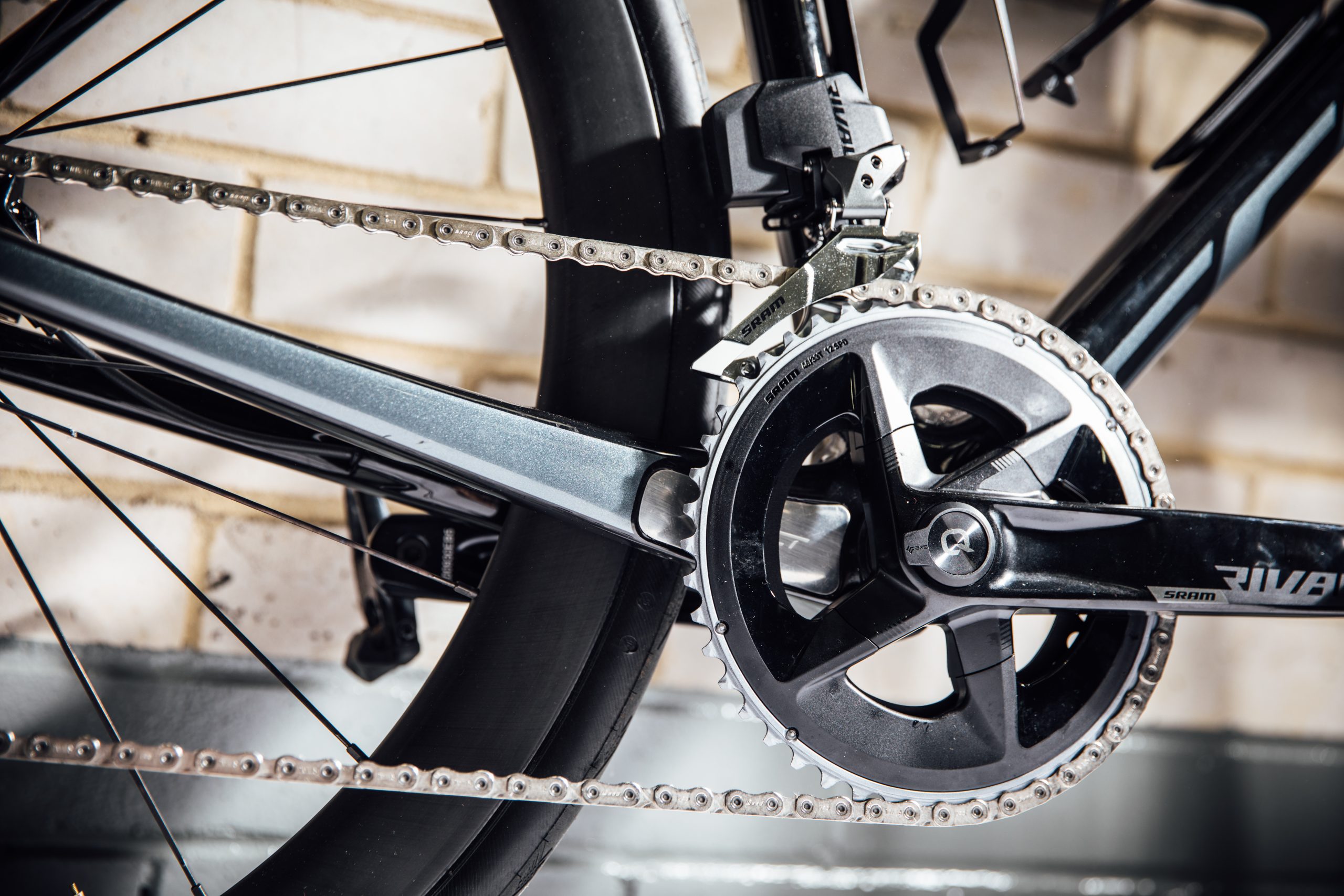
All SRAM's electronic groupsets use the same battery, which plugs into the back of the front and rear derailleurs and is recharged by a USB cradle. There's the option to add wired satellite shifters (which SRAM calls Blips) to Red and Force AXS and wireless Blips to all the groupsets.
Turning to its mechanical groupsets, Apex is SRAM's entry level, available as an 11-speed single chainring groupset. Next up the ladder is the 11-speed Rival, which was named to rival Shimano 105. SRAM Force is top of the mechanical groupset hierarchy and roughly comparable to the old 11-speed Shimano Ultegra.
All SRAM's groupsets are available with a single ring 1x option at the front and every model in the range is also available with hydraulic disc brakes. There are rim brake options for some groupsets as well.
Across the mechanical range, SRAM uses 'DoubleTap' shifting - which means that the single gear lever on each side does both the up and down shift. On the right, a short push takes you into a smaller cog (more resistance) on the cassette, and a long swipe takes you into a bigger cog (less resistance).
On the left, a quick click of the lever takes you into a smaller chainring, and a longer push moves you into a bigger ring - though obviously this doesn't apply on the 1x ranges where you get a brake-only left lever or can fit a dropper post control lever.
In 2019, SRAM introduced its AXS groupsets - initially only available in SRAM Red AXS spec, this quickly trickled down to SRAM Force AXS. Then, in 2021, it added SRAM Rival AXS.
The overhaul is about more than just the extra sprocket offered by the 12-speed cassette. SRAM has downsized the chainrings - a 50/37 being the largest double ring option initially available, although SRAM has subsequently introduced chainrings up to 56 teeth.
In compensation, its cassettes start with a 10-tooth smallest sprocket and offer options up to 36 teeth. This gives riders greater range via the cassette, with smaller incremental jumps, means you need to shift less between the chainrings and it gives a lower lowest gear. You're losing nothing in terms of top end ratios - a 50x10 is bigger than a 53x11.
The AXS app is used to configure the system, but you don't have to use it - though without doing so you'll miss out on some gearing customisation. It's also used for firmware updates and to check battery status.
Since launch, SRAM has added two other options to eTap AXS. First is the Wide chainset (not available at Red level), designed to offer better clearance for wider tyres, particularly on gravel bikes, and which also offers lower gearing with smaller chainrings.

Second is XPLR, which gives a single chainring set-up with a 10-44 cassette, designed to provide gear ratios tailored for gravel riding. This is available at Red, Force, Rival and Apex levels.
For even more versatility, AXS systems are compatible with SRAM Eagle AXS mountain bike groupsets. That gives the option of a "mullet build" where road bike shifters and chainset are paired with an MTB cassette and derailleur for a massive single chainring gear range of 10-52 teeth.
There's also an in-series Eagle option for the 12-speed Apex groupset, which allows you to use a 10-50, 10-52 or 11-52 cassette with either electronic or mechanical shifting.
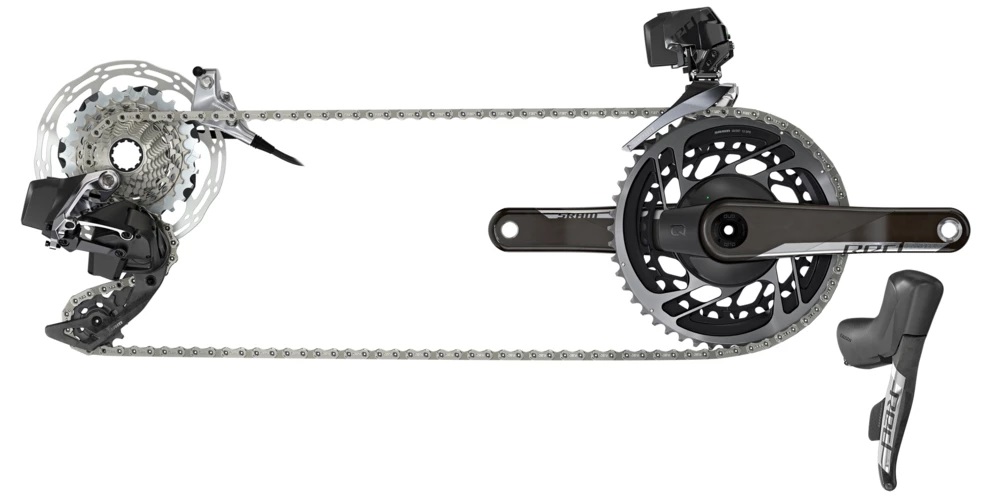
Specifications
Reasons to buy
Reasons to avoid
SRAM Red eTap AXS, being wireless, is impressively light; it uses SRAM's own communication protocol 'AIREA' instead of ANT+ or Bluetooth.
To shift using eTap, you move into a smaller cog at the rear by pressing the paddle behind the right brake lever. You move into a larger cog by pressing the paddle behind the left lever. The front mech is operated by pressing both levers together, although the system is fully programmable and you can alter paddle function or set it up with sequential shifting when it sorts out the front changes for you.
There's a power meter option, although the meter is integrated with the chainset, so you can't easily swap chainring sizes and need to replace the whole thing once your chainrings become worn.
SRAM also offers XPLR gearing with Red eTap AXS.

Specifications
Reasons to buy
Reasons to avoid
Like Red eTap AXS, SRAM Force eTap AXS is a 12-speed electronic groupset available with single or double chainrings and hydraulic disc brakes.
Force eTap AXS shares many features with SRAM Red eTap AXS, just in a slightly more affordable package with a couple of minor shortcuts. That includes the use of less carbon fibre and the absence of some lever adjustability. As with Red, there are options for a power meter and XPLR gearing, as well as the Wide chainset option.
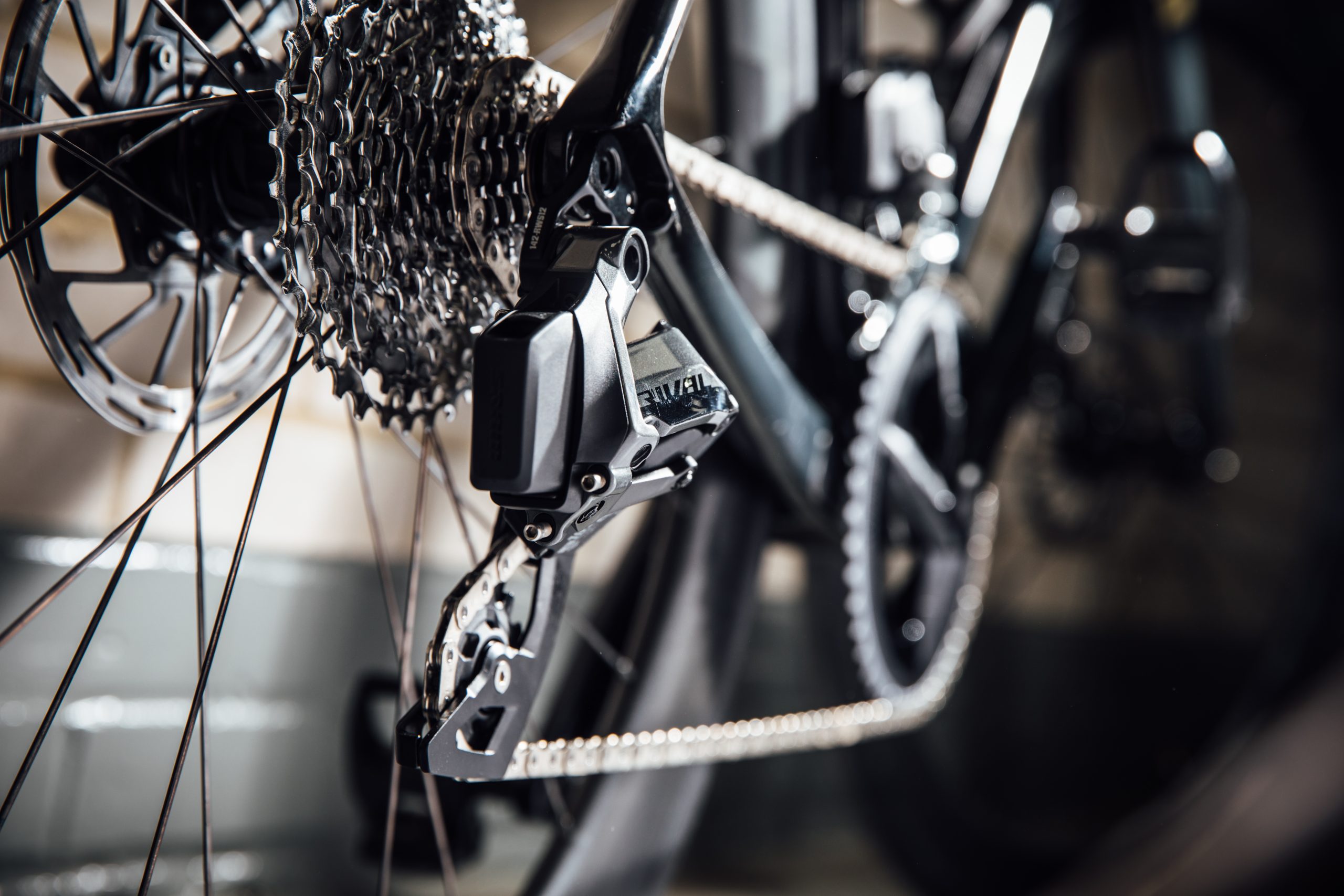
Specifications
Reasons to buy
Reasons to avoid
As with the higher spec eTap AXS groupsets, SRAM Rival eTap AXS is 12-speed and includes hydraulic disc brakes, XPLR and Wide options. There's also a single sided power meter for a relatively small outlay, currently £230.
The major difference between Rival and SRAM's more expensive groupsets is that the cranks, levers and rear mechs move from being constructed from carbon fibre to aluminium, with a steel front derailleur cage.
The groupset comes with a rear derailleur which includes a clutch mechanism to reduce chainslap, although the clutch uses a spring rather than the fluid-based Orbit version used by Red and Force.
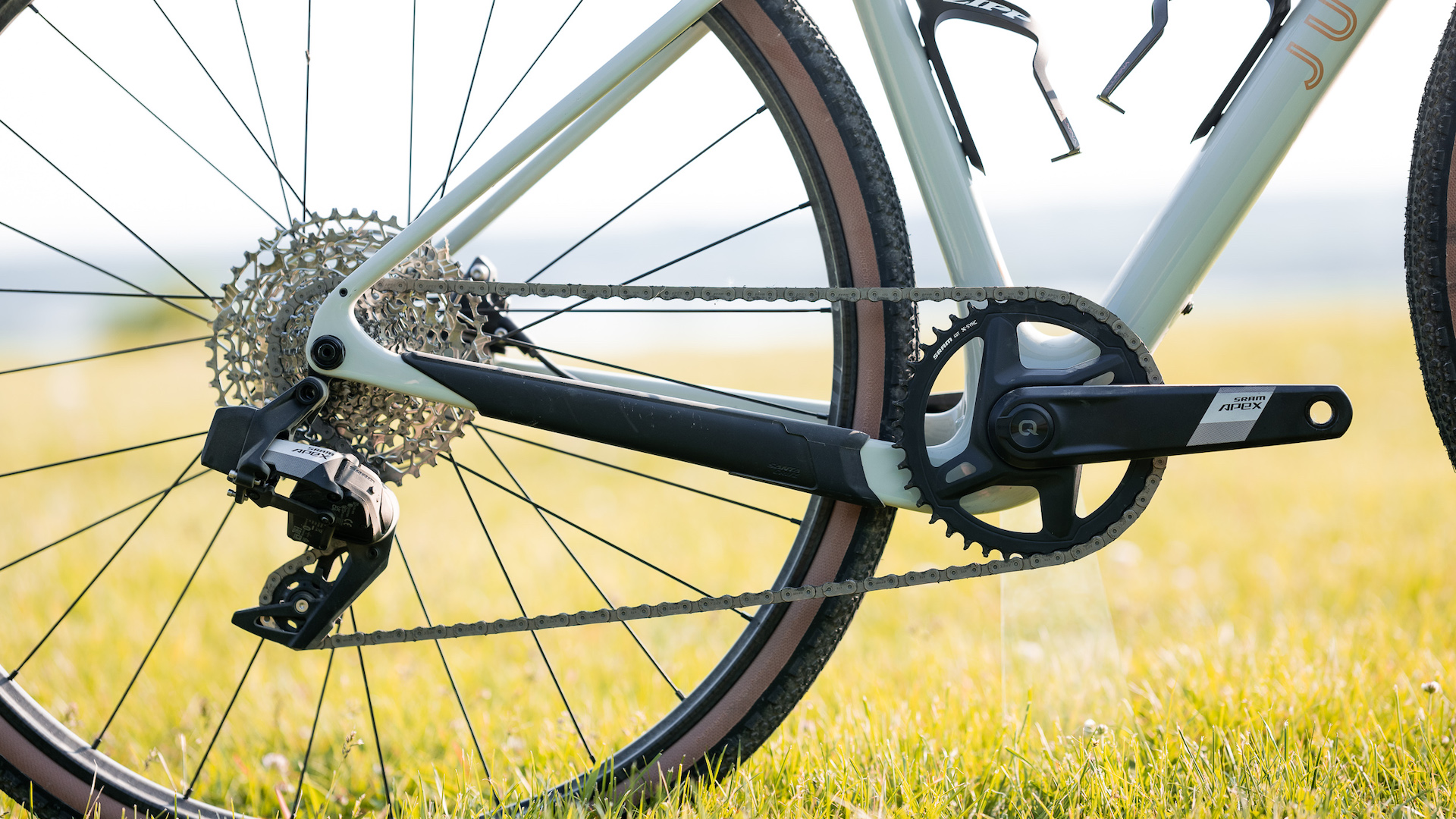
SRAM Apex XPLR/Eagle AXS
Specifications
Reasons to buy
Reasons to avoid
SRAM introduced two 12-speed electronic shifting options to its fourth tier Apex groupset in June 2023. It's done things a bit differently though, as Apex AXS is only available as a single chainring option with Wide spacing.
There are XPLR 10-36, 10-42 and 11-44t cassette options, which are compatible with SRAM's higher spec single ring groupsets. The 11-44 cassette fits on a standard 11-speed freehub rather than needing an XDR freehub body.
At the same time, SRAM launched an electronic Apex Eagle AXS option. This gives very wide ratios, up to 10-52. Apex Eagle uses MTB tech and spacing, so it's not cross-compatible with the road-going AXS groupsets. There is an 11-52 cassette which fits on an 11-speed freehub.
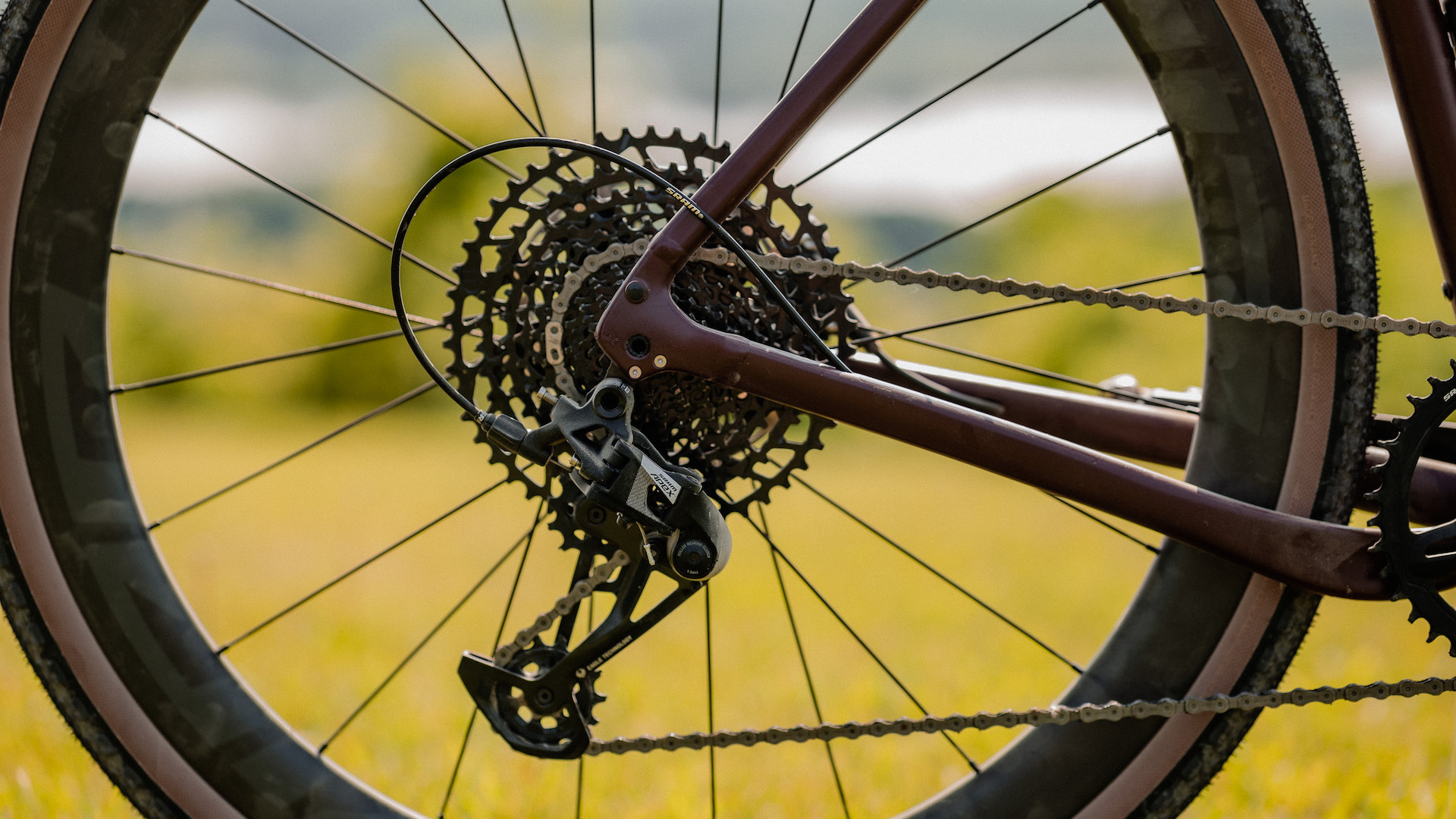
SRAM Apex XPLR/Eagle mechanical
Specifications
Reasons to buy
Reasons to avoid
Also in the SRAM Apex 12-speed bundle were mechanical shifting options for both the XPLR and Eagle groupsets. As with the AXS electronic versions, they are single ring only, with XPLR using road groupset specifications and Eagle following MTB standards.
Again, there are very wide gear range options, up to 10-42 for XPLR and 10-52 for Eagle.
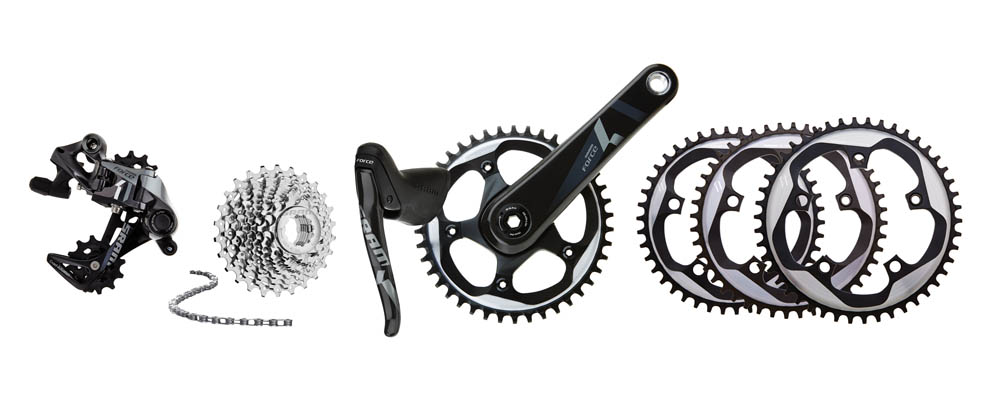
Specifications
Reasons to buy
Reasons to avoid
SRAM Force is a mechanical groupset available in either double chainring 22-speed guise or as a single ring 11-speed option. There's a choice of rim (for 22-speed) or hydraulic disc brakes. It's targeted to be on par with Shimano Ultegra.
The 22-speed version has never achieved much traction in a space dominated by Shimano Ultegra and 105. It's nicely built though with quality features like carbon crank arms to save weight. It also uses SRAM's Direct Actuation system in which, unlike Shimano mechanical systems, there's no gearing up between the cable pull at the lever and the derailleur, which SRAM says leads to more precise shifting.
The single ring Force 1 groupset is a popular choice for gravel and cyclocross bikes. It can accommodate cassettes up to 10-42, and comes with chainrings from 38 to 54 tooth. A Roller Bearing Clutch derailleur helps guard against chain slap and ensures smooth shifting.
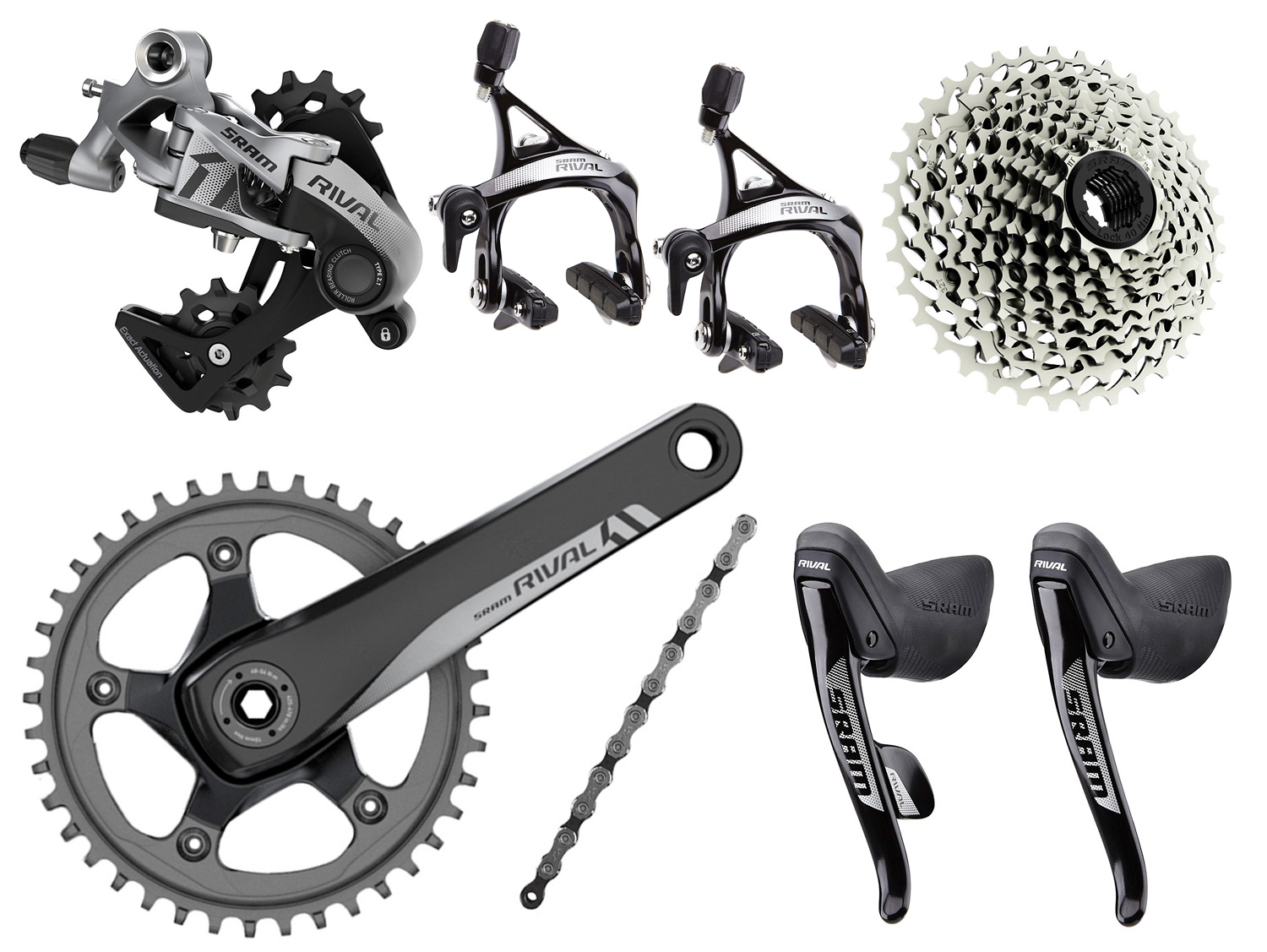
Specifications
Reasons to buy
Reasons to avoid
Like SRAM Force, you can get SRAM Rival in 2x11-speed configuration, 1x (as pictured above), and with hydraulic disc or mechanical rim brakes (for the 2x11 option). The 1x groupset comes with a rear derailleur which includes a clutch mechanism to reduce chainslap, the major difference from Force being an aluminium rather than carbon chainset.
Rival 1 often appears on mid-priced gravel bikes too.
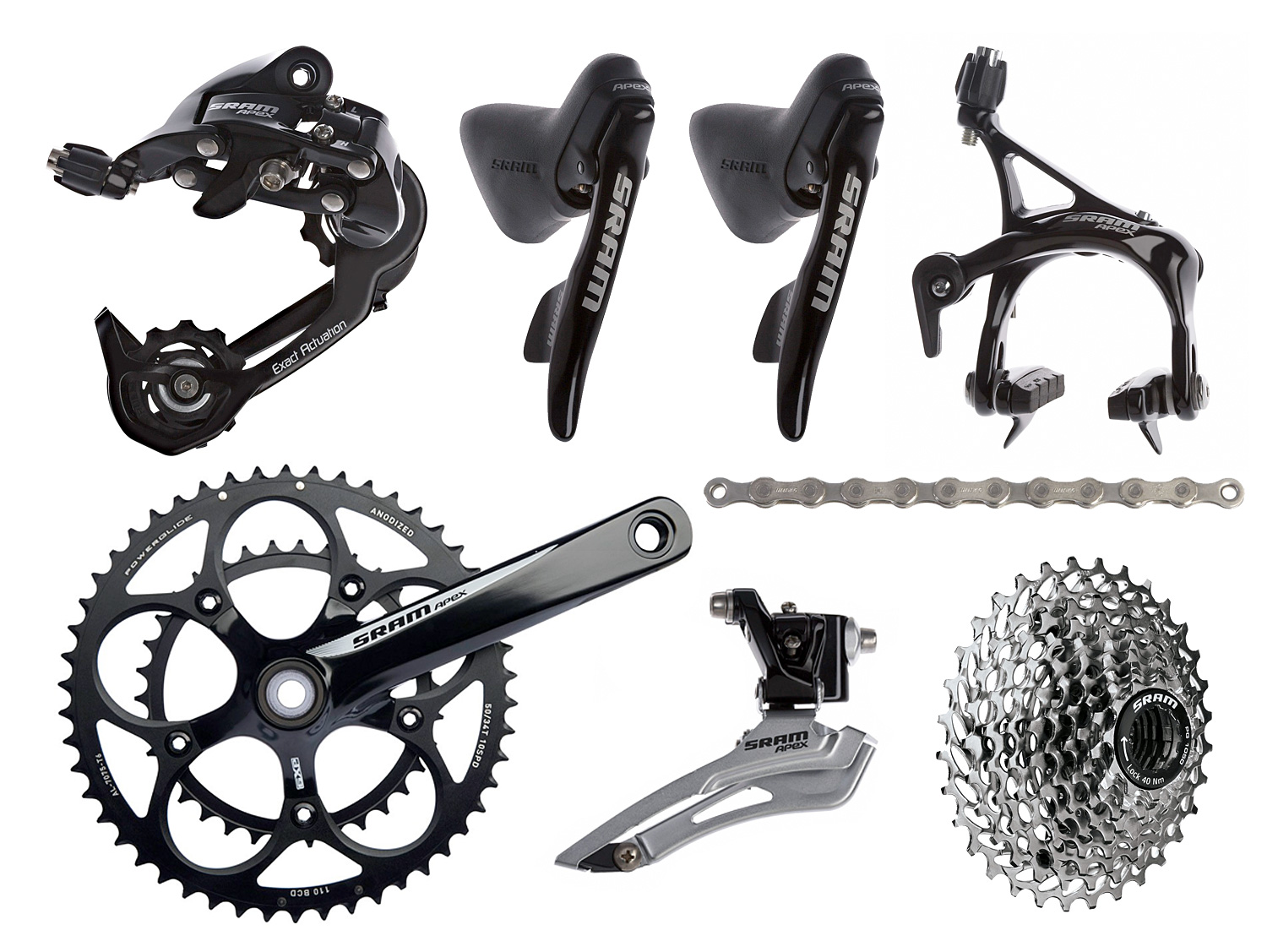
Specifications
Reasons to buy
Reasons to avoid
SRAM Apex is now only available as an 11-speed single ring groupset, which you may find specced on some entry level gravel bikes.
As with the higher spec 1x options, it allows you to use an 11-42 tooth cassette for wide range for off-road riding.
SRAM groupset weights and RRPs
| Row 0 - Cell 0 | What is it? | Weight* | RRP** |
| SRAM RED eTap HRD AXS, 2x | Electronic, disc, 12 speed | 2518g | £3349.00 |
| SRAM RED eTap HRD AXS, 1x | As above, single chainring | 2103g | £2849 |
| SRAM RED eTAP AXS, 2x | Electronic, rim, 12 speed | 2254g | £3159 |
| SRAM RED eTAP AXS, 1x | As above, single chainring | 2070g | £2559 |
| SRAM RED eTap HRD | Electronic, disc, 12 speed | TBC | £2658 |
| SRAM RED eTap | Electronic, rim, 12 speed | TBC | £2472 |
| SRAM Force AXS HRD 2x | Electronic, disc, 12 speed | 2896g | £2228 |
| SRAM Rival eTap AXS HRD 2x | Electronic, disc, 12 speed | 3205g | £1314 |
| SRAM Rival eTap AXS 1x | Electronic, disc, 12 speed, 1x | 2,776g | £1102 |
| SRAM Apex XPLR AXS | Electronic, disc, 12 speed, 1x | 2,976g | £1,227 |
| SRAM Apex Eagle AXS | Electronic, disc, 12 speed, 1x | 3,267g | £1,299 |
| SRAM Apex XPLR mechanical | Mechanical, disc, 12 speed, 1x | 2,872g | £986 |
| SRAM Apex Eagle mechanical | Mechanical, disc, 12 speed, 1x | 3,062g | £1,015 |
| SRAM Force 1 | Mechanical, disc, single chainring | 2466g | £1234 |
| SRAM Force 22 HRD | Mechanical, disc, 11 speed | Unconfirmed | £1127 |
| SRAM Force 22 | Mechanical, rim, 11 speed | 2097g | £975 |
| SRAM Rival 1 | Mechanical, disc, single chainring | 2690g | £979 |
| SRAM Rival 22 HRD | Mechanical, disc, 11 speed | Unconfirmed | £1025 |
| SRAM Rival 22 | Mechanical, rim, 11 speed | 2348g | £691 |
| SRAM Apex 1 | Mechanial, disc, single chainring | 2719g | £828 |
* Weights will always be estimates, as they'll vary depending upon chainring size, crank length, cassettes used and some official weights do not include components such as cables and DOT fluid /hoses for disc brakes.
** RRPs are based upon SRAM's official retail price of components added together, Retailers create their own RRPs, based upon the cost of individual components, so listed prices will vary.Not all retailer prices contain every element of the groupset, and you may need to factor in additional parts.
Campagnolo groupset hierarchy
Campagnolo, affectionately referred to as "Campag" or "Campy", is a company rich in cycling heritage. The Italian brand can boast of equipping the winning bikes of the 2020 and 2021 Tours de France, as well as many previous editions. It was the dominant racing groupset maker until the 2000s.
Historically it is famous for inventing the rear derailleur and many other key innovations, such as quick release skewers.
The entry-level groupset, Centaur, is 11 speed, with next-up Chorus sitting just below the Record components, while Super Record sits atop the Campagnolo mechanical groupset hierarchy. Chorus, Record and Super Record are all 12-speed groupsets.
Campag offers one electronic groupset, Super Record Wireless, which is the most expensive commercially available groupset.
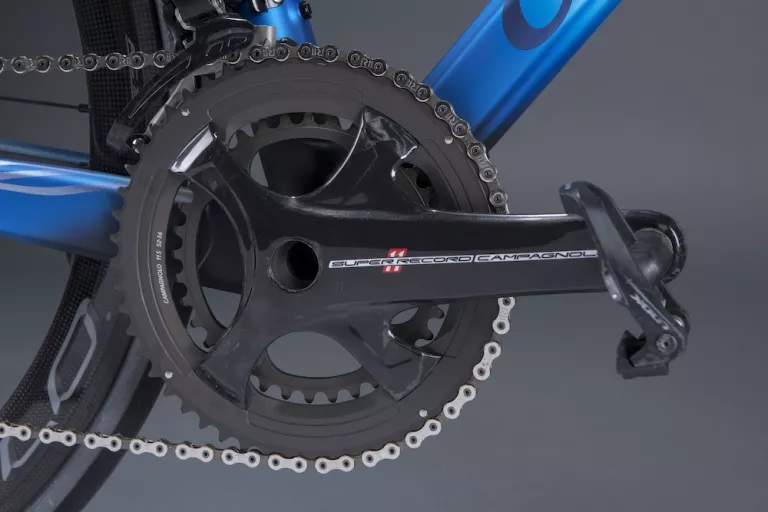
Campagnolo's shifting system for all but its most recent Super Record Wireless groupset differs from Shimano and SRAM with a lever behind the brake on the 'Ergopower' shifters which moves the chain one way, and a thumb lever on the inside of the shifter which sends it the other way. The other magic trick is 'Ultrashift', which makes it possible to give the lever a longer push to smash through multiple gears on the cassette in one go.
The brand's systems are well known for their distinctive 'clunk' - something Campag says dedicated users value so much that the original electronic system was developed to provide the same degree of feedback.
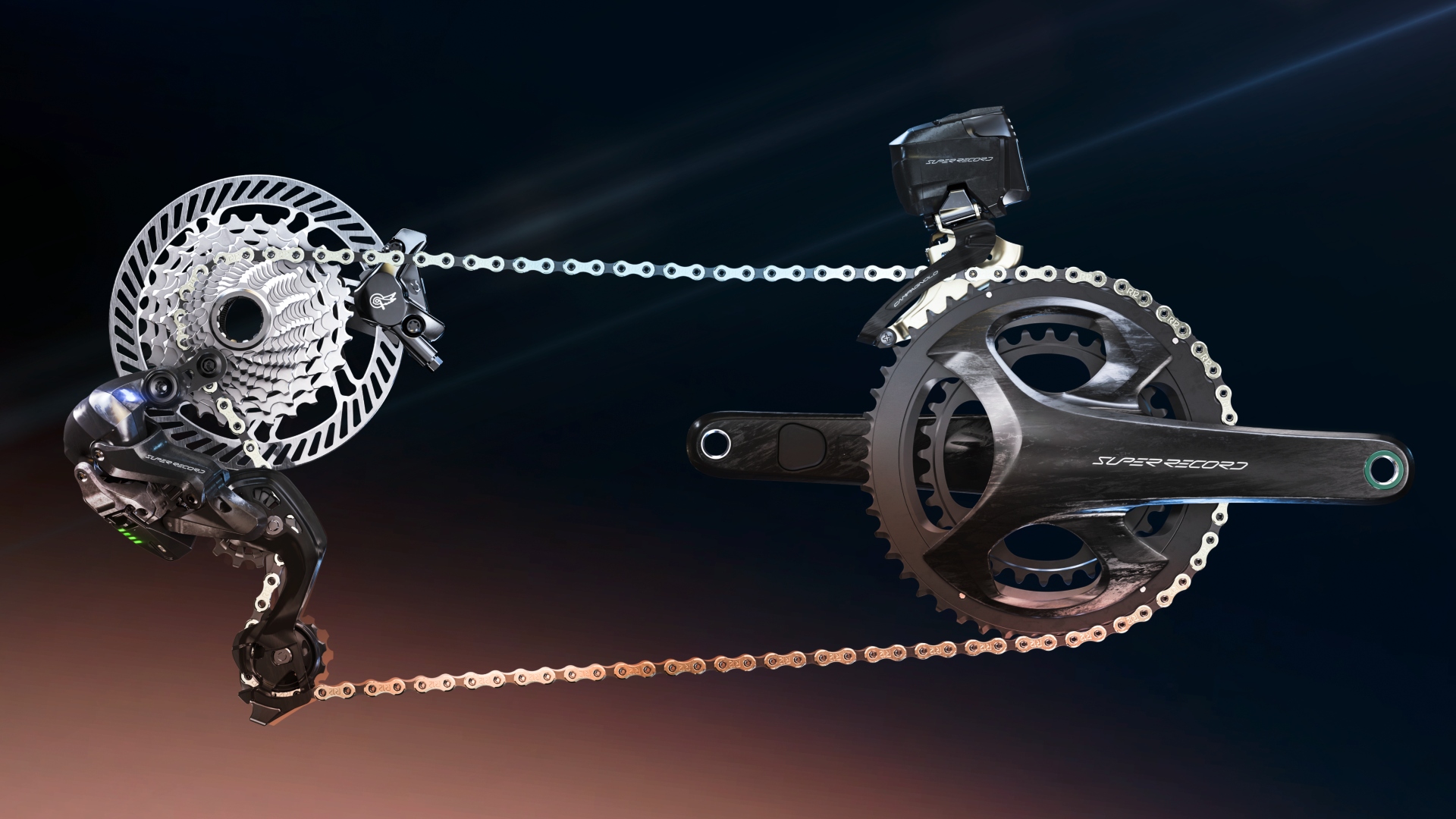
Campagnolo Super Record Wireless 12-speed groupset
Specifications
Reasons to buy
Reasons to avoid
Launched in May 2023, Super Record Wireless is Campagnolo's only electronic groupset. As its name says, it's totally wireless, with the derailleurs powered by a battery attached to each. Unlike SRAM's system, the batteries have a different shape and cannot be swapped front to rear though.
For the Campagnolo purist, the major change is the replacement of the thumb lever with two shift levers behind the brake lever, which sit above and below each other. Our tester, Tim Russon, found them 'easy to use from the hoods' but noted that he had to 'cock [his] wrist at an unnatural angle to reach the higher button on either side when in the drops.' This takes getting used to, especially if you're accustomed to Di2 shifters.
There's more change with new cassettes that start with a 10 tooth sprocket and go up to 29 teeth maximum. These are paired with smaller chainrings to give a similar set of ratios to a conventional groupset starting at 11 speeds. The cassettes need to be mounted to wheels with a Campagnolo N3W freehub.
The Super Record Wireless groupset is disc brake only. Tim Russon, described the disc brakes as 'superb,' praising them as 'quiet, powerful, and easy to control'—a highpoint of the groupset.
The verdict? While the Super Record Wireless is appealing in its technology and rarity, we think it lacks the performance or features to justify its high price, especially when compared to the Shimano Dura-Ace Di2 (without a power meter).
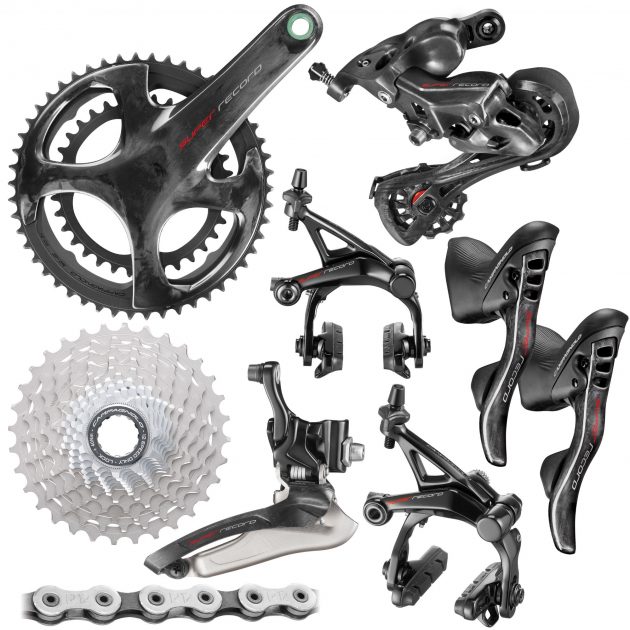
Specifications
Reasons to buy
Reasons to avoid
Campagnolo Super Record mechanical is available in disc brake or plain old rim brake guise.
There are three cassette options - 11-29, 11-32 and 11-34 - the reasoning being that racers don't need to stick to smaller gear ratios in order to minimise gaps between cogs with the 12-speed system.
Being top of the mechanical shifting performance ladder, Super Record is loaded with carbon and titanium, allowing for a low overall weight. The crankset, for example, is carbon, with alloy chainrings and a titanium axle, the derailleurs are predominantly carbon with ceramic bearings used and the body of the shifter is constructed from composite.
Alongside the impressive performance of the disc brakes, we've always found Campagnolo's direct mount rim brakes - available down to Chorus level - quick to react and effective.
The derailleurs allow for full use of the cassette, in either chainring, without chainrub on the front mech, and the chainsets come in 53/39, 52/36 and 50/34 combos.
Campagnolo Record
Specifications
Reasons to buy
Reasons to avoid
The performance differences between Super Record and Record aren't huge - there's a little bit less carbon, which reflects in a slight weight increase - for example, the crankset weighs 651g as opposed to 603g at Super Record standard.
The shifters still have a composite body, as used in the majority of the derailleurs' structure, though the ceramic bearings have disappeared from the rear and been replaced by bushings.
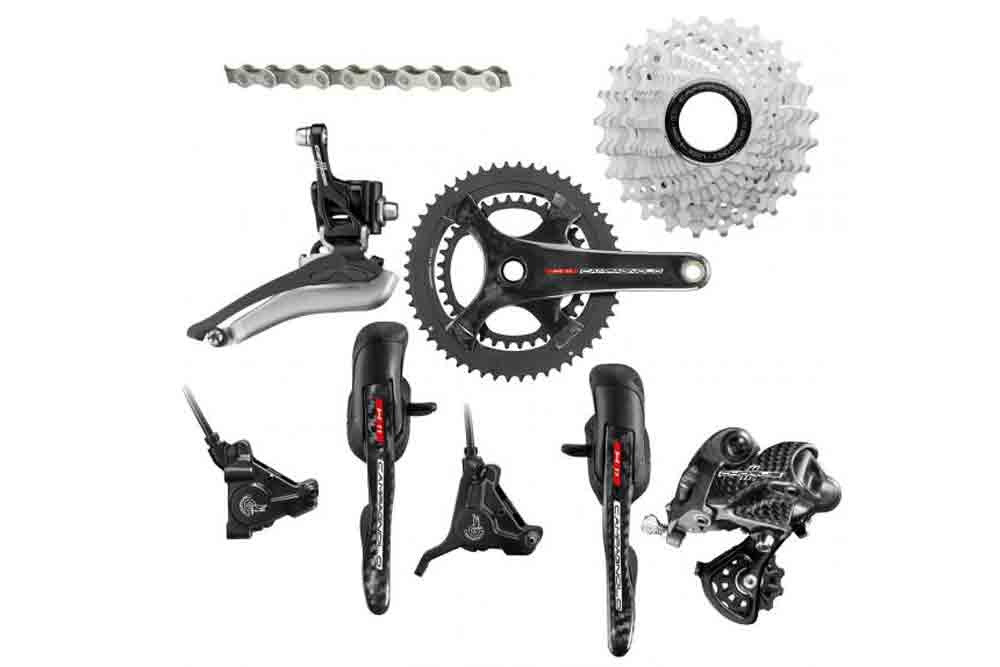
Specifications
Reasons to buy
Reasons to avoid
Chrous comes with disc or rim brakes, and with the same 12 speeds as the upper echelons offer.
The rear derailleur uses rubber pulleys as opposed to the ceramic bearings at Super Record level. The crankset has been beefed up to 683g (compared to 603g for Super Record), and there are similar weight increases across the groupset.
Since it's functionally the same, Chorus components make a cheaper swap-out is Super Record or Record parts need replacement.
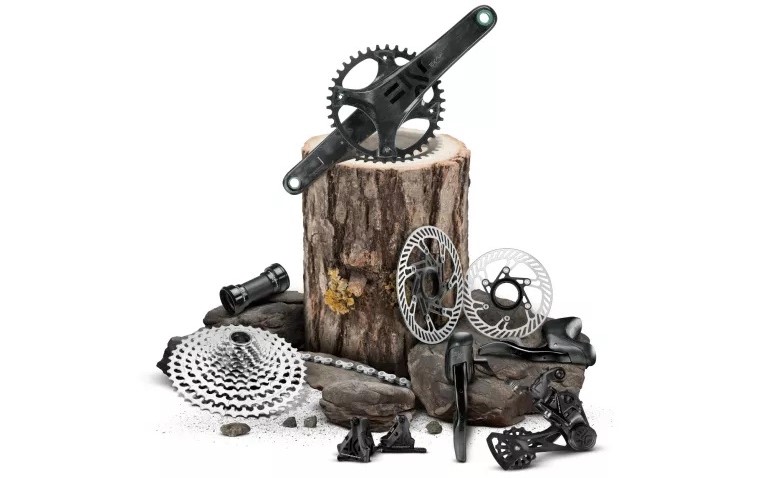
Specifications
Reasons to buy
Reasons to avoid
In September 2020, Campagnolo added Ekar - a 13-speed gravel specific groupset, available in mechanical only, disc brake configuration. We've got a full review of Campagnolo Ekar available to read.
Campagnolo Ekar retails at around £1,449 / $1,764 / €1,696. Given Campagnolo is often known for being a high ticket choice, the prices surprised us by being closer than expected to the likes of SRAM and Shimano's offerings.
It's light too, with weights starting at 2,385g in the lightest configuration with a 9-36 cassette.
As well as going 13-speed, Campagnolo adjusted the thumb paddles on Ekar, making them easier to reach when riding off-road.
Cranksets are available in 38T, 40T, 42T and 44T, with cassettes at 9-36T, 9-42T and 10-44T. A clutch rear mech helps to keep the chain quiet, and the narrow-wide tooth design also aims to prevent chain drops.
You do need wheels designed to work with Ekar cassettes, using the N3W freehub format. All new Campagnolo wheels will use this standard and it's backward compatible with Campagnolo's 11 and 12-speed road cassettes.
Campagnolo groupset weights and RRPs
| Super Record Wireless, 12 speed | Electronic, disc, 12 speed | 2520g | £4499.99 |
| Super Record 12 speed disc | Mechanical, disc, 12 speed | 2453g | £3937 |
| Super Record 12 speed rim | Mechanical, rim, 12 speed | 2041g | £2600 |
| Record 12 speed, disc | Mechanical, disc, 12 speed | 2453g | £2144 |
| Record 12 speed | Mechanical, rim, 12 speed | 2213g | £1750 |
| Chorus | Mechanical, rim, 12 speed | Unconfirmed | £1330.65 |
| Centaur | Mechanical, rim, 11 speed | Unconfirmed | £588.12 |
| Campagnolo Ekar | Mechanical, disc, 13-speed | 2,385g | £1449 |
* Weights will always be estimates, as they'll vary depending upon chainring size, crank length, cassettes used and some official weights do not include components such as cables and mineral oil/hoses for disc brakes.
** RRPs are based upon Campagnolo’s official retail price of components added together. Retailers create their own RRPs, based upon the cost of individual components, so listed prices will vary.
Buyer's guide to components of a road bike groupset
Shifters
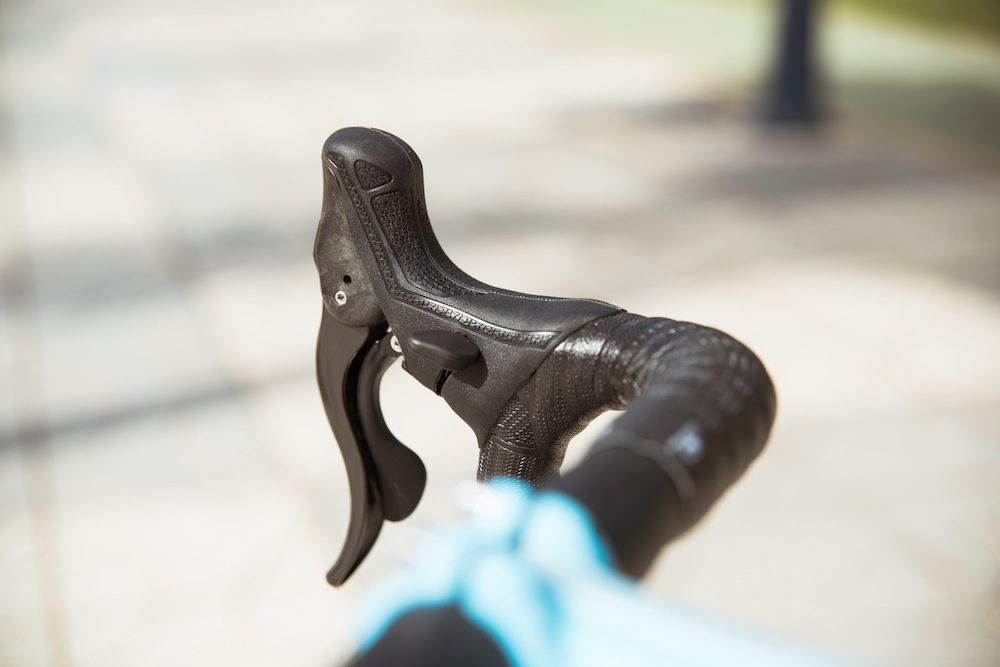
The shifters on a road bike are used to change gear. Shimano's STI (Shimano Total Integration) shifters are the most common design. The brake lever can be pushed inwards (sideways) to change up into an easier gear. To change down, there is a second lever behind the first that can be separately pushed inwards. To apply the brake, the brake lever is pulled backwards, towards the rider, which also moves the shift levers backwards.
With shifters from Campagnolo and SRAM you brake in the same way but they each have slightly different shift mechanisms. With Campag, except for the latest Super Record Wireless, you shift down using a shifter behind the brake lever, and change up using a thumb shifter on the inside of the hoods.
On mechanical SRAM groupsets, you shift up by pushing the lever in one notch, and change down by continuing to push it in slightly further. However with SRAM’s eTap electronic systems you shift up the rear derailleur by pressing the right shifter, down at the back by pushing the left shifter, and push both simultaneously to shift the front derailleur. Like other electronic systems it’s programmable, so you can change this.
Brakes
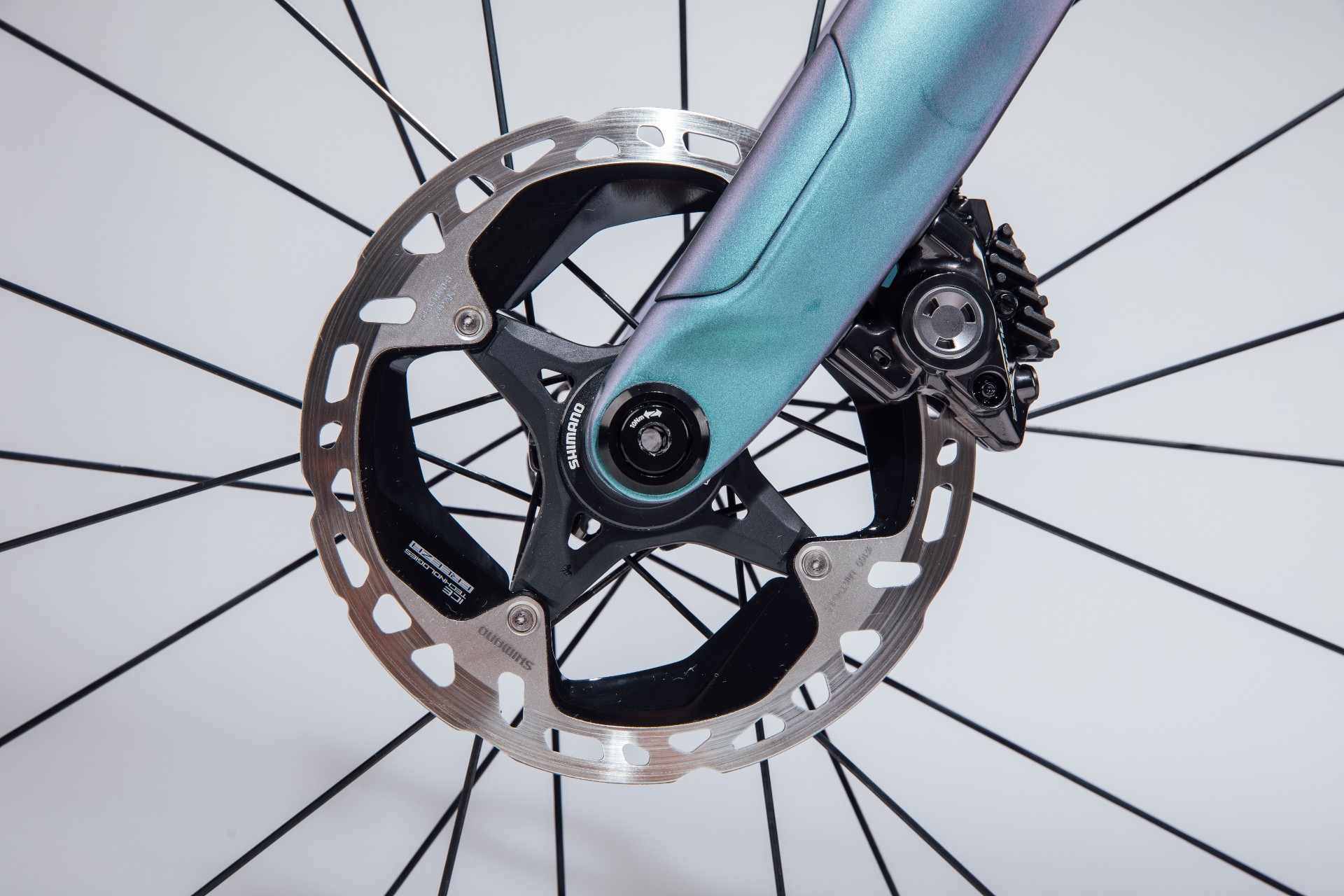
Disc brakes have taken over in a big way in the last few years and many bikes are only available with them, although you can still find bikes which can be purchased with either rim or disc brakes and some that are rim brake only.
Hydraulic disc brakes have superior performance to mechanical ones and, since the hydraulic hoses are a closed system, they’re not as prone to performance degradation as mechanical disc brakes.
Chainset
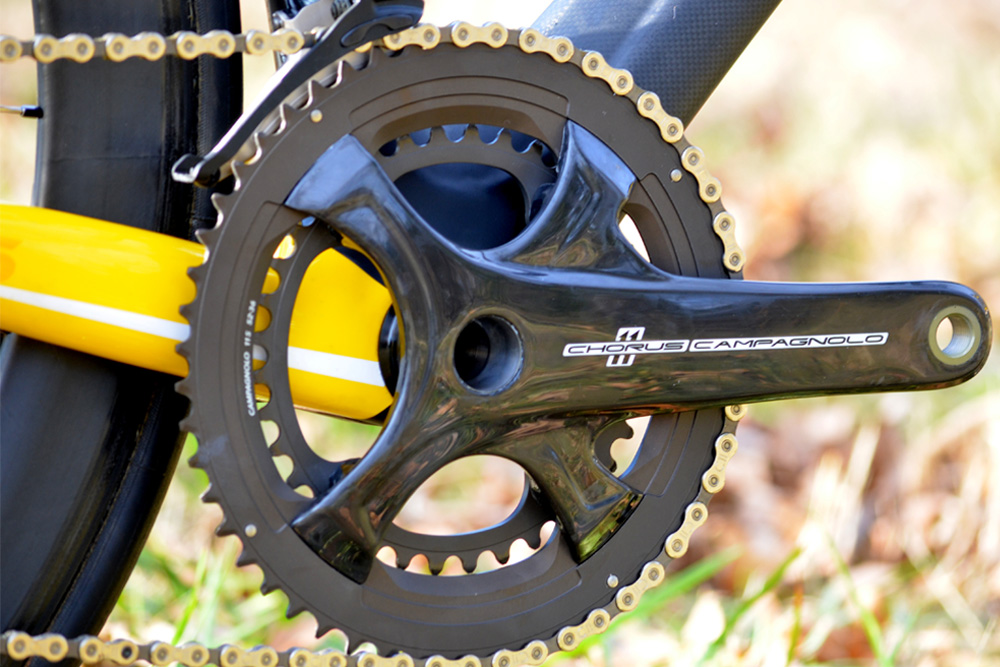
Chainsets housing the front gears can be split into three main categories – one-by, double and triple. A one-by system (also called single ring: you’ll often see it designated by a 1x at the end of the groupset name) has a single chainring, a double has two chainrings while a triple has (you guessed it) three.
The chainset also features the cranks, which attach to the pedals. The length of the crank arms can vary, typically ranging from 160mm to 180mm. The length of the cranks that come fitted to a complete bike is usually related to its size — for example, a 56cm frame will often have 172.5mm cranks whereas smaller frame sizes may drop to 170mm.
Longer cranks offer a bigger mechanical advantage and larger effective gear, but can be harder to turn. Shorter cranks are sometimes favoured in criteriums, as they offer more ground clearance to let you pedal around corners and they’re popular with triathletes, as they allow them to keep up a higher cadence and adopt a more aero position.
Single ring chainsets
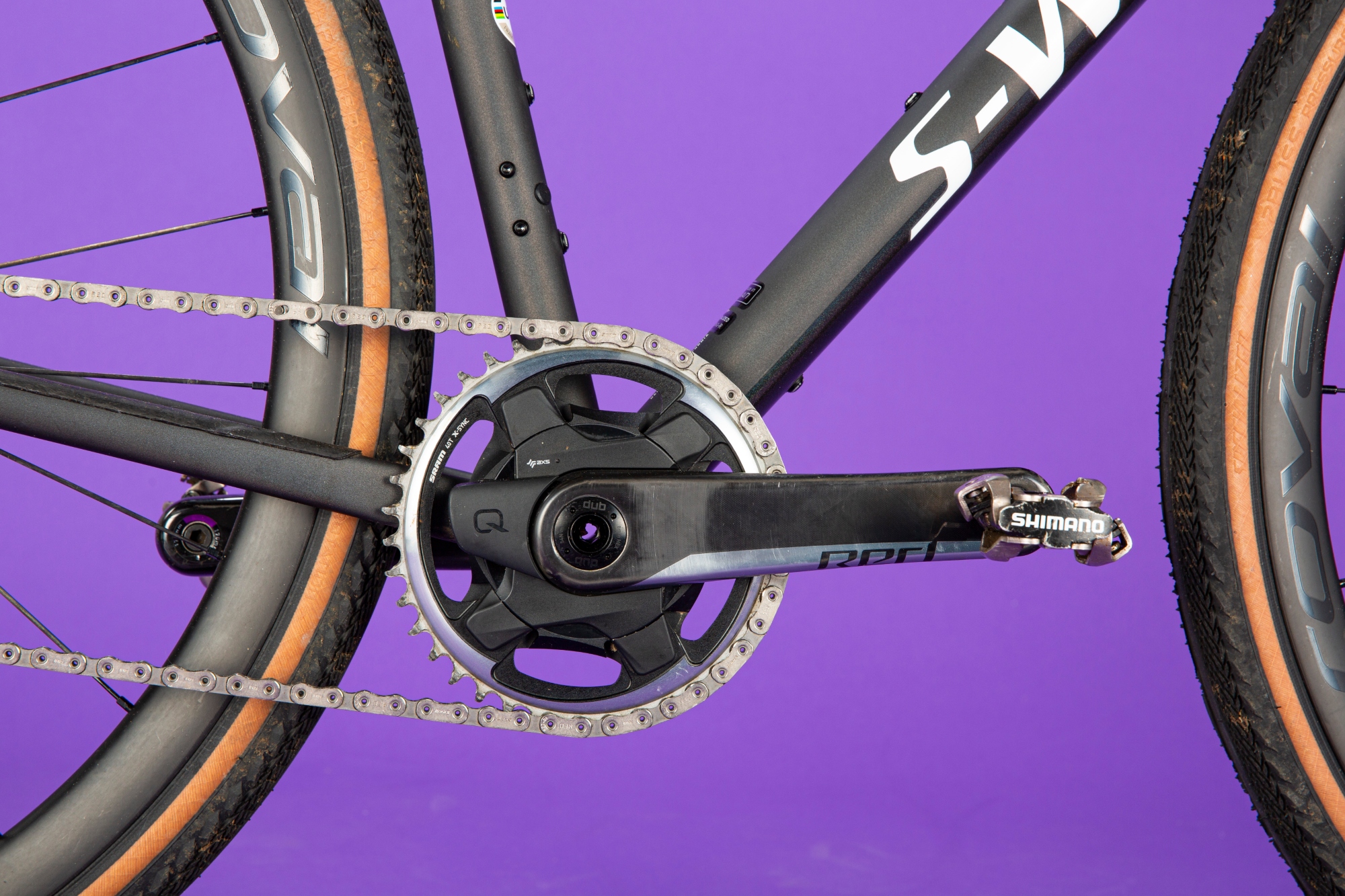
Single ring systems make up for only having one chainring by offering much wider range cassettes at the rear, with 11-42 being a common range and SRAM electronic systems going as wide as 10-52 teeth. There are larger gaps between ratios than with a double chainset, but the latter will have overlapping gear ranges between the two rings, so the actual number of usable gears and the overall range can be similar with a 1x system.
Benefits of a single ring system include better chain retention, since the teeth on the chainset can be made deeper and alternate between wide and narrow teeth to mesh better with the chain. 1x groupsets also have a clutch in the rear derailleur to help keep the chain engaged. Not having a front derailleur means there’s less to go wrong and there’s a weight saving and better aerodynamics too.
Double chainsets
Double chainsets are available in different ratios, with 53/39t being the standard combination favoured by road racers (for those new to cycling, the numbers refer to the number of teeth on the chainring and the bigger the number, the bigger the gear. A bigger front gear is harder to push but can achieve higher speeds).
Compact chainsets have a 50/34t ratio and are currently the most common gearing fitted to road bikes. The smaller 34-tooth chainring makes this type of chainset ideal for riding in hilly terrain. A third, increasingly common ratio known as mid-compact, with a 52/36 ratio, is also available, and is good if you want to be able to push a big gear down fast descents, but also want a smaller inner ring to fall back on in the hills.
You’ll also find two chainring set-ups dubbed “super-compact” or “subcompact”. They’re popular on gravel bikes, where the lower ratios they provide help you get along off road. Common options include 48/32 and 46/30 but you’ll find others offered.
Triple chainsets
Triple chainsets are uncommon now and usually confined to cheaper bikes, where the rear shifting offers fewer ratios and narrower range. The front shifting is a bit more tricky than a double ring system to keep working well and there’s extra weight from the third ring.
They are sometimes found on touring bikes as they offer a wide range of gears, which is useful when riding a bike laden down with heavy kit. The most common ratio is 50/39/30t.
Cassette
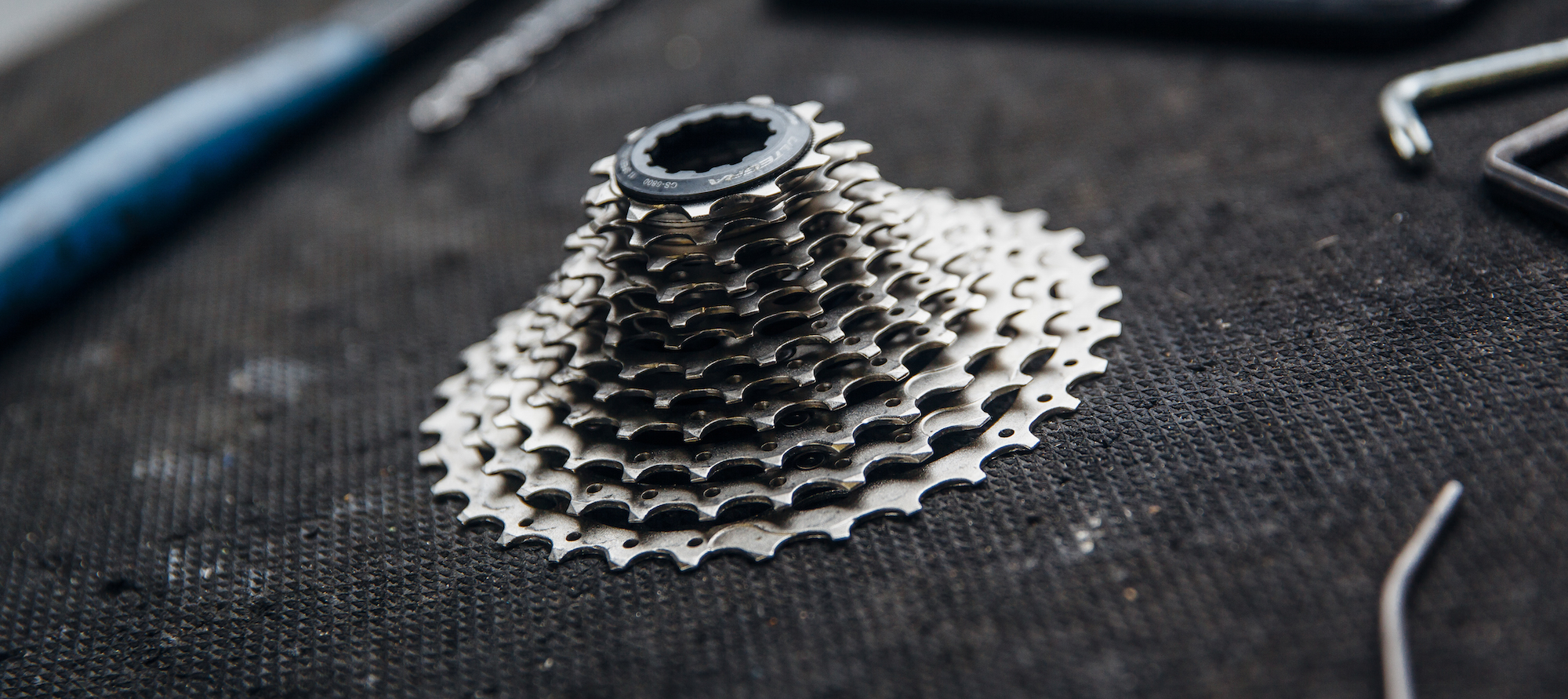
The cassette refers to the collection of sprockets on the rear wheel. These are available in a wide range of different ratios. An 11-speed cassette will have 11 sprockets on the cassette, which can be arranged with close ratios such as 11-25t, which will be good for time trialling and racing on flatter terrain, as the close gears allow for fine adjustment and very smooth shifting, or a wider ratio like 11-32t, which gives you more gear range to choose from when riding in hilly terrain.
You have to have a cassette which matches the number of ratios in your groupset so you can’t, for example, use an 11-speed cassette on a 10-speed groupset.
You can change your cassette and it is common for cyclists to own a few different ratios. However, it is important to remember that the size of the biggest sprocket on a cassette is limited by the length of the cage on the rear derailleur, so check with your local bike shop or on manufacturers’ sites online before you splash out on a 32-tooth cassette!
Chain
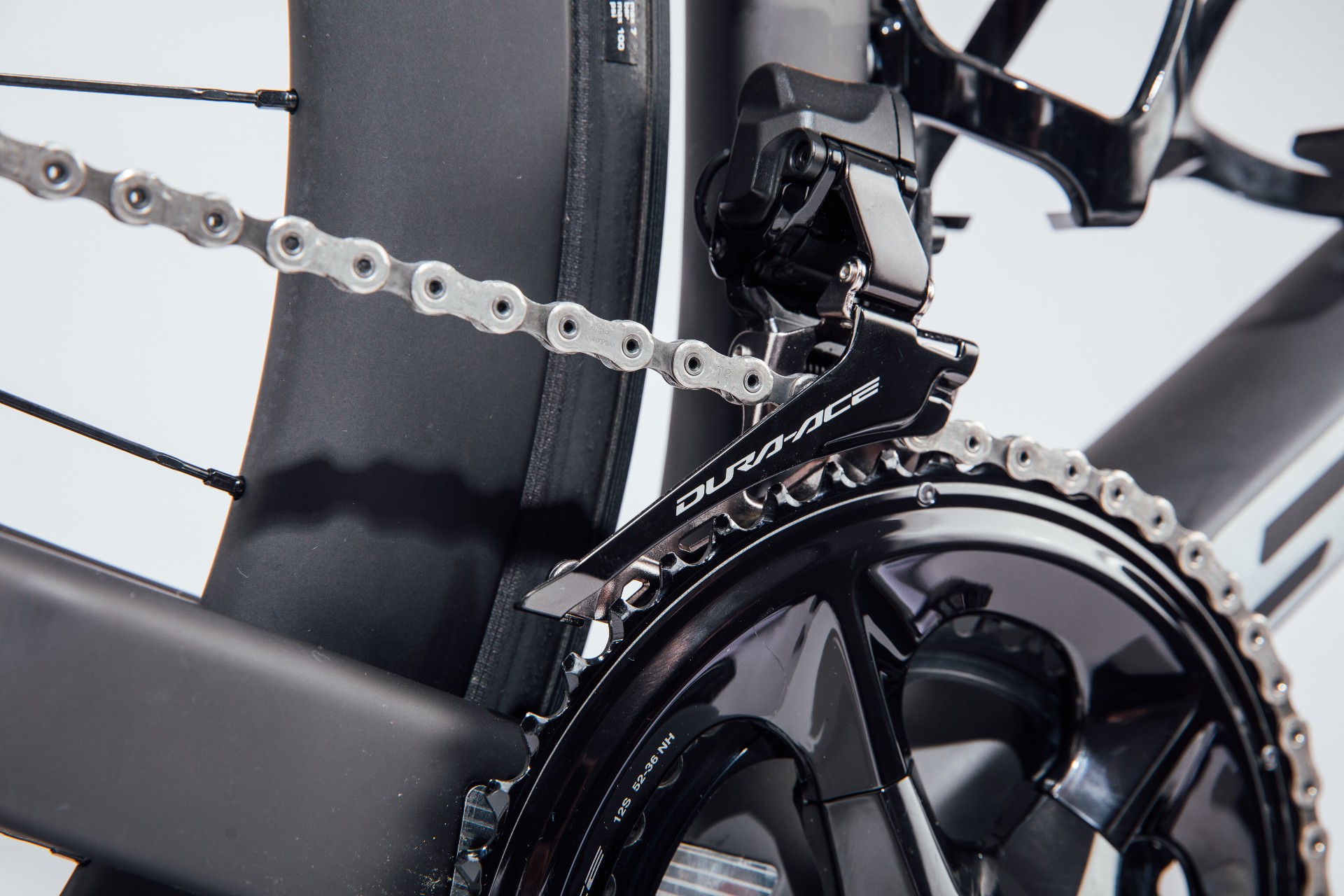
The type of chain is dependent on the range of gears, i.e. a 10-speed groupset requires a 10-speed chain; an 8-speed chain is considerably wider than an 11-speed chain. More expensive chains feature alloy coatings that are more resistant to wear, and are often lighter. Chains, like cassettes, wear over time, so will need to be replaced periodically. You can buy a chain wear indicator inexpensively, to check to see when your chain needs replacing.
Derailleurs

The derailleurs (also called mechs) are responsible for guiding the chain from one sprocket to the next. A cable is usually responsible for the shifting, but electronic groupsets, such as Shimano 105 Di2, SRAM Red eTap AXS, or Campagnolo Super Record Wireless, use small motors to move the derailleur.
Rear derailleurs come with specs to handle different sizes of cassette and there’s often a “short cage” or “mid/long cage” option. Make sure that a replacement derailleur matches your cassette both in number of speeds and cassette range.
Derailleurs for 1x systems (see above) have a clutch built into them to keep the chain taut, as do some designed for use with double chainrings. Again, your derailleur needs to match your cassette.
The more expensive rear derailleurs feature ceramic bearings in the jockey wheels.
Front derailleurs are either band on (where the derailleur includes a metal clamp that bolts around the frame) or braze on (where the frame has bolts built in to attach the derailleur to), so make sure you select the correct option if purchasing separately from your frame.
Band on refers to a circular clamp to attach to the frame. This is not always possible, as bike frames are not always round. To counter this, braze on derailleurs are riveted or bolted to the frame and are now the more common option.
Electronic vs mechanical shifting
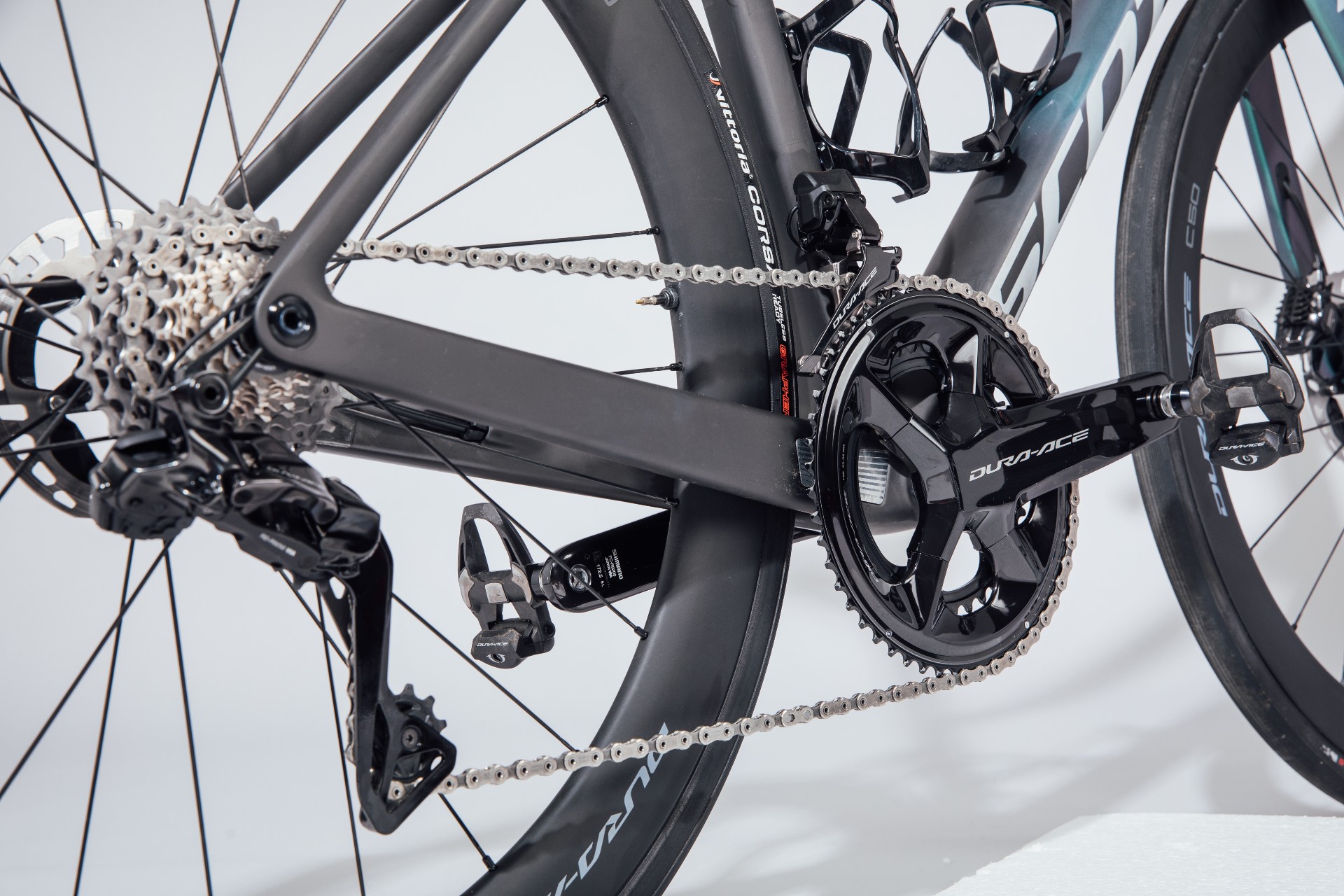
If you've got more than $4,000 / £3,000 to spend on a new bike then you will likely be faced with a choice of whether to go for electronic or mechanical shifting. Which you choose to go for depends really upon what your priorities are and the sort of riding you do.
For out and out performance, electronic groupsets are the natural choice, as shown by the fact that riders in the professional peloton now choose to use them thanks to the slightly sharper shifting and the ability to shift through multiple gears at once. And don't be put off by the fact that the batteries have to be recharged (once in a blue moon) or the idea that it might be susceptible to the elements (in fact we'd argue that gear cables are much more vulnerable to wet and muddy roads than electronic wires).
Brands generally put their best tech into their electronic groupsets too. If you want a 12-speed Shimano or SRAM system you have to choose electronic, for example.
Of course there are still many benefits to mechanical groupsets. The shifting on most mechanical groupsets is still very good, and if something goes seriously wrong then it's much easier to fix than electronic. But perhaps most importantly, it's also considerably cheaper, with individual components being much cheaper to replace in mechanical systems.
What do you get for your money when buying a road bike groupset?
Groupsets vary in price a great deal, but what changes as the price goes up?
The first thing to consider is weight. A lighter bike will accelerate faster and climb quicker than a heavy one, but components also need to be strong and stiff. As the price of components increases the weight decreases. In order to maintain strength, durability and stiffness of the lighter components, more expensive materials are required. For example, an entry level groupset will have a steel cassette, with a top end cassette often featuring some titanium gears.
Performance
Manufacturing tolerances are much closer on a top end groupset, which means that with an increased price, you get improved shifting between gears. More expensive components are smoother, more precise and quicker to shift. Electronic groupsets are currently the benchmark in shifting performance, offering smoother shifting when changing gear under load, such as when riding out of the saddle or grinding up a hill. In these situations the lower end groupsets can be very clunky and strained, whereas the electronic shifting is sublime.
Something to consider is that the shifting performance does tend to level out for the top two tiers. For example, the shifting quality between Ultegra and Dura-Ace is very similar, and the difference between the two primarily comes down to weight.
More expensive chainsets tend to be lighter and stiffer too. This can transform a bike, as a stiff crankset is more efficient at transferring the power from the pedals into forward motion. A chainring that flexes slightly under load will absorb energy, and decrease shifting performance too.
Durability
As one would expect, durability generally improves as you move up in price. Quality mid-tier components such as shifters and derailleurs last a very long time if properly maintained. However it is important to consider that the top-tier groupsets, such as Super Record and Dura-Ace, are not designed for workhorse everyday use.
These components are designed to be the lightest, with everyday use a secondary concern, which means that durability of groupsets tends to peak around the second highest tier.
Running costs should also be factored in, as chains and cassettes are expected to wear out and be replaced several times throughout the lifetime of a bike. Replacing a Super Record chain and cassette will incur a much greater cost than a Chorus equivalent, although in many cases there's the option to swap out to cheaper parts from a lower tier groupset, often with only a small increase in weight.
Other road bike groupset options
The big three are Shimano, Campagnolo and SRAM, but there are a couple of other groupset options for road bikes:
Rotor road bike groupset
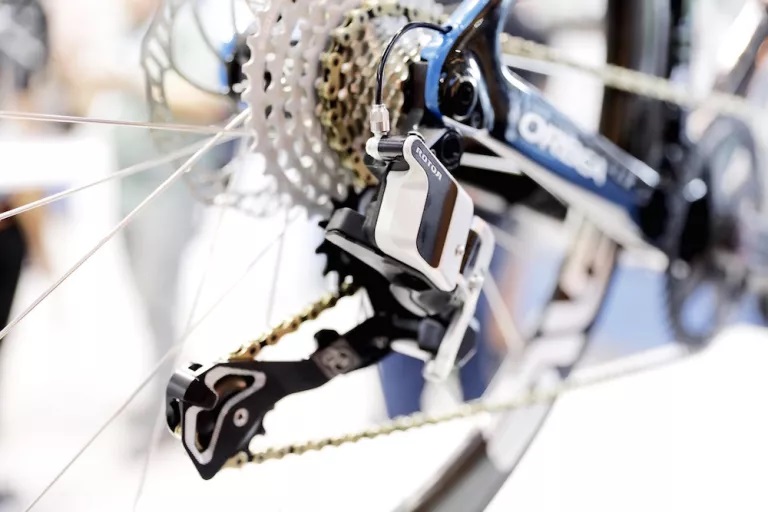
Spanish manufacturer Rotor has long been making cranksets and power meters, but also has a 1x13-speed groupset. This uses hydraulic fluid to move the derailleurs (and brake calipers) rather than cables or wires. It's pitched its groupset particularly at gravel bikes.
FSA road bike groupset
Another rarer groupset is FSA K-Force WE, with WE standing for Wireless Electronic. Best known for its cranksets and finishing kit like handlebars and seatposts, the Italian company also sells the K-Force electronic groupset. This is 12-speed and uses a wireless connection between the shifters and the derailleurs, which are powered by a battery in the frame, for a configuration that's similar to that in the latest 12-speed Shimano Dura-Ace and Ultegra.
Microshift
On entry-level bikes, you’ll sometimes see Microshift components specified. They’re cheaper than Shimano and generally compatible with Shimano’s groupsets, so often a single Microshift component is paired with Shimano parts, although the company does make full groupsets too.
Top Tips when looking at road bike groupsets on built bikes
When buying a bike look at the components it comes with. It is common for bike manufacturers to supply a bike with a complete name brand groupset, minus the brakes and chainset. These are sometimes (but not always) swapped out for cheaper parts from the same maker or a different brand to bring the overall price of the bike down.
If you are unsure, enquire to establish what you are getting. In some instances it can also be worth investing in a quality frame with a lower end groupset, with a mind to upgrading the components at a later date.

Thank you for reading 20 articles this month* Join now for unlimited access
Enjoy your first month for just £1 / $1 / €1
*Read 5 free articles per month without a subscription

Join now for unlimited access
Try first month for just £1 / $1 / €1
Get The Leadout Newsletter
The latest race content, interviews, features, reviews and expert buying guides, direct to your inbox!
Michelle Arthurs-Brennan the Editor of Cycling Weekly website. An NCTJ qualified traditional journalist by trade, Michelle began her career working for local newspapers. She's worked within the cycling industry since 2012, and joined the Cycling Weekly team in 2017, having previously been Editor at Total Women's Cycling. Prior to welcoming her first daughter in 2022, Michelle raced on the road, track, and in time trials, and still rides as much as she can - albeit a fair proportion indoors, for now.
Michelle is on maternity leave from April 2025 until spring 2026.
- Sonny EvansWriter
-
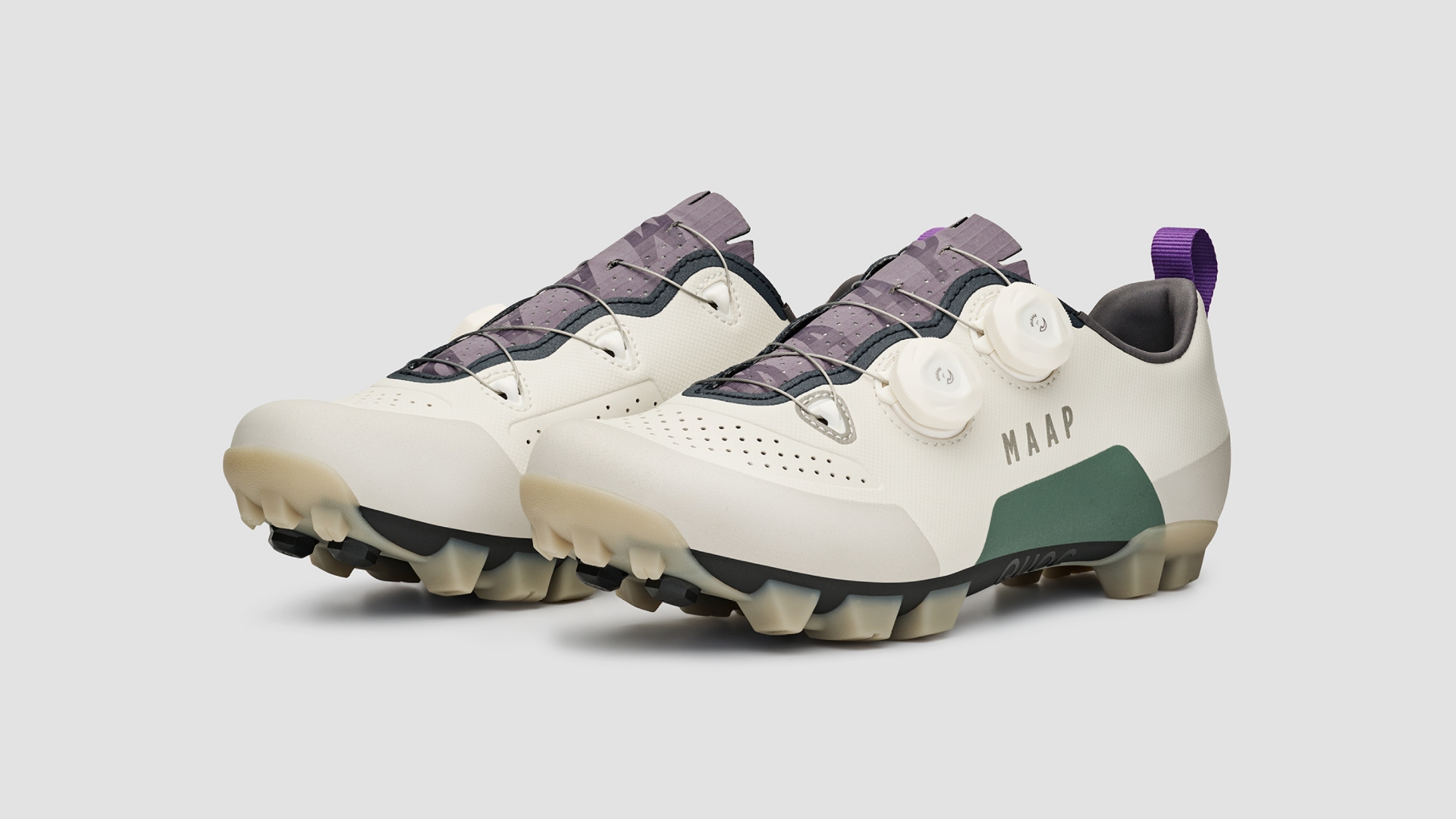 MAAP teams up with QUOC; first collab is the Gran Tourer XC shoe
MAAP teams up with QUOC; first collab is the Gran Tourer XC shoeDesigned for off-road riding the limited-edition shoe features a new colourway and other features
By Luke Friend Published
-
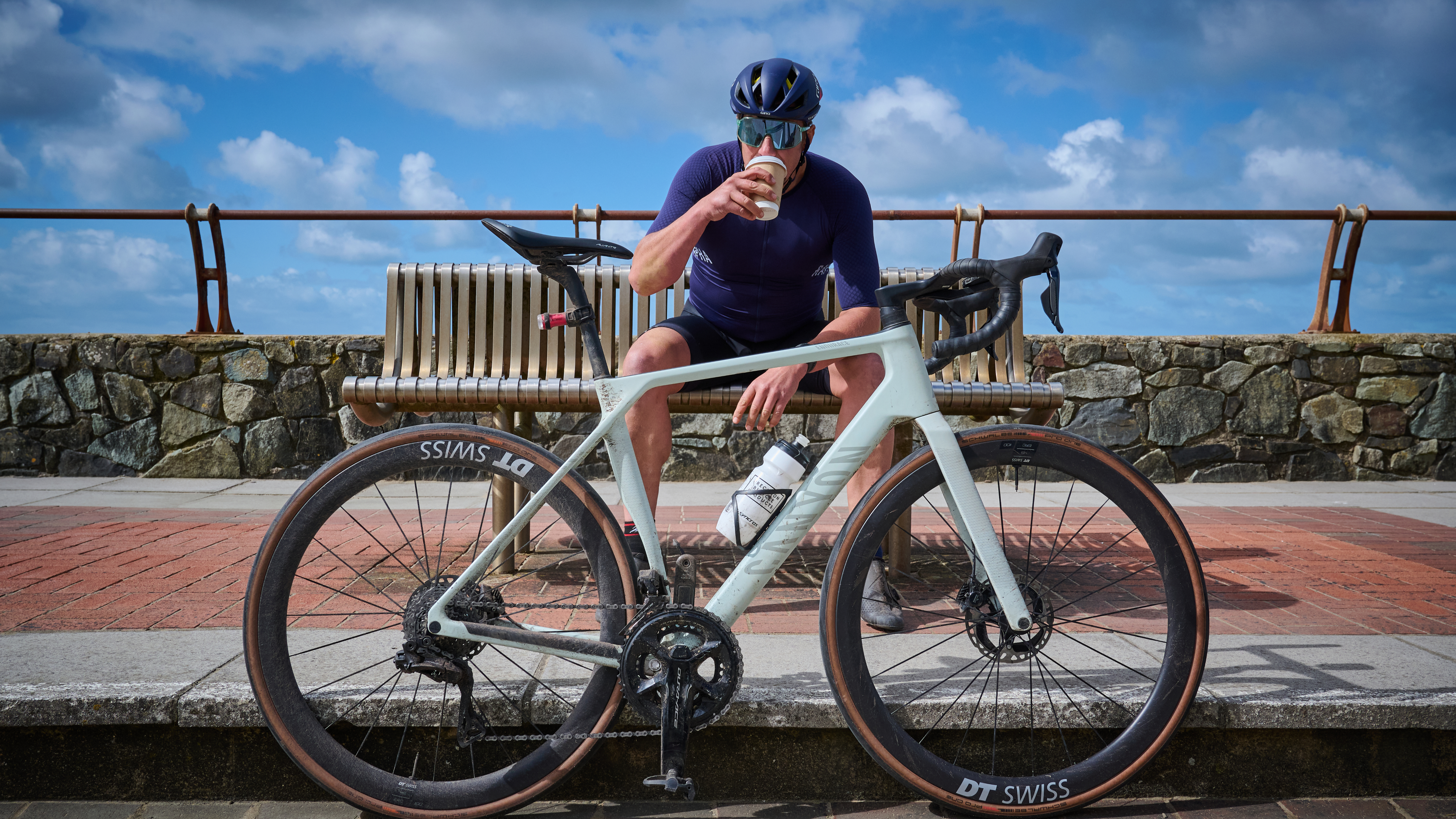 'I've already lost 2 kilograms and my head feels clearer': I'm a month into sober curiosity and have never felt so good on the bike
'I've already lost 2 kilograms and my head feels clearer': I'm a month into sober curiosity and have never felt so good on the bikeBeginning to fear for his health, Steve Shrubsall swapped beer and telly for turbo sessions and books, here’s what happened
By Stephen Shrubsall Published
